When you become less dependent on the system, what happens to the system has less of an impact on you. Unfortunately, it appears that our system is heading into a full-blown meltdown, and a significant portion of the population is feverishly making preparations in anticipation of what is coming.
According to Reuters, it has been estimated that there are now approximately 20 million “preppers” in the United States…
Brook Morgan surveyed booths at the “Survival & Prepper Show” in Colorado that were stocked with boxes of ammunition, mounds of trauma medical kits, and every type of knife imaginable.
A self-described “30-year-old lesbian from Indiana,” Morgan is one of a new breed of Americans getting ready to survive political upheaval and natural catastrophes, a pursuit that until recently was largely associated with far-right movements such as white nationalists since the 1980s.
Researchers say the number of preppers has doubled in size to about 20 million since 2017.
There is a subset of that group that has decided that the best way to prepare is to go “off grid”.
It is being reported that “more than 250,000 people in the U.S.” have chosen to adopt such a lifestyle…
As energy costs and home prices continue to rise, more Americans are choosing to live off-grid. According to one estimate, more than 250,000 people in the U.S. have an off-grid lifestyle. While the potential cost savings are certainly attractive, technology and interest in tiny homes, shipping container homes and other energy-efficient housing alternatives are allowing families interested in sustainable lifestyles to move to off-grid living.
If you are thinking of making a similar move, you need to do your research.
Most of us are extremely dependent on the grid, and many find that making a switch to a radically different lifestyle is quite challenging…
Living off the grid means committing to sourcing everything you need to survive and thrive independently: food, shelter, energy and most importantly: water. It’s empowering, until the moment things don’t work. Like when you’re halfway through a delightful hot shower at the end of a January day and the water pump suddenly stops working, sending you into the frozen darkness with a wet headful of shampoo and some tools to address the problem.
For a lot of people, joining a community of others that have adopted an “off grid” lifestyle is very helpful. For example, about 55 miles south of Salt Lake City hundreds of survivalists are living in a very large community that is completely off the grid…
A community of society-shunning Americans launched a survivalist haven in the Utah desert after finding themselves alienated from the modern world.
Hundreds of people have set themselves up to live off the land under ‘Operation Self-Reliance,’ feeling that getting off-the-grid is the solution to a crumbling culture.
This particular community was originally founded by a 74-year-old man named Philip Gleason, and he is warning that “a variety of apocalyptic scenarios could play out in the coming years”…
Gleason said he fears a variety of apocalyptic scenarios could play out in the coming years, from a power grid failure taking down America’s electricity, to nuclear war and cyber attacks.
‘This is just history repeating itself,’ he cautioned. ‘At the start of any cultural revolution, the people that control their food are the ones that come out on top.’
As Americans consistently share that they are losing faith in the nation’s institutions, those that have made a new life on Riverbed Ranch have essentially set up their own self-surviving nation state.
Of course it probably wasn’t a great idea for them to share what they are doing with such a large audience, because when things do get really bad large numbers of desperate people may start heading that direction.
Most of the time, families that choose to live an “off grid” lifestyle just do it on their own.
Heather Graesser and her husband once owned a large home near Denver, but now they are much happier living an “off grid” lifestyle…
Ten years ago I was living a typical suburban life on the outskirts of Denver. My husband, Casey, and I were both teachers. We lived in a four-bedroom house with a small yard where our two kids liked to play.
Today our life looks radically different. We live entirely off the grid in a 300-square-foot home that we built from straw bales and cob, a natural building material made from soil, water, and other organic matter. We rely on solar power for electricity and rain collection for water, and we use a drop toilet to create “humanure” — compost made from human waste.
We’ve left the conventional world behind. But along the way we’ve created a much more luxurious and free lifestyle than the one we were living in suburbia.
Good for them.
These days, it is becoming increasingly difficult to live a “normal” middle class lifestyle because the cost of housing has become so painful.
In fact, an entirely new category known as “impossibly unaffordable” has been created because home prices have become so expensive in certain cities…
Anyone with half an eye on the housing market over the last two decades will know that in many countries, not least the United States, it’s become much more difficult to buy a home.
But a new report sums up the feeling of many potential home buyers by creating a category that labels some major cities as “impossibly unaffordable.”
The report compared average incomes with average home prices. It found that pandemic-driven demand for homes with outside space, land use policies aimed at limiting urban sprawl, and investors piling into markets had sent prices soaring.
Living “off grid” is often much cheaper than living a conventional lifestyle. And living “off grid” will also give you a much better chance of shielding yourself from the endless violence that we see all around us.
Recently, I was deeply shocked to read about a 42-year-old man that fired 28 shots at women and children at a family splash pad in Rochester Hills, Michigan…
An eight-year-old boy is fighting for his life after being shot in the head by a rampaging gunman at a family splash pad as seven others were also gunned down.
The violent attack took place in Rochester Hills, Michigan, around 5pm Saturday after the shooter fired 28 rounds from a handgun in a seemingly random attack, peppering women and children at the Brooklands Plaza Splash Pad outside Detroit.
The gunman fled the scene to a nearby home within half a mile of the splash pad, leading to a tense hours-long standoff that ended when the shooter – described as a 42-year-old white male who lived with his mother – died by suicide.
You would have to be completely and utterly evil to do something like that.
Sadly, our entire society is saturated with evil at this point.
So I can definitely understand why so many people just want to get away from it all.
Things are really bad now, but they are going to get a whole lot worse during the chaotic years that are in front of us.
Ultimately, I think that large numbers of people are going to regret not adopting an “off grid” lifestyle while they still had the opportunity to do so.
Our society is already in the process of collapsing all around us, and those that understand what is happening are getting prepared for what is coming.
Michael’s new book entitled “Chaos” is available in paperback and for the Kindle on Amazon.com, and you can subscribe to his Substack newsletter at michaeltsnyder.substack.com.
]]>Accept the reality
There are many who believe that a future blackout impacting the U.S. is a matter of “if” and not “when,” and that’s exactly why preparations are so important. No one really knows what’s going to happen in the future. (Related: How to live without electricity like the Amish.)
Build your survival stockpile
Grow your own food and medicine. Create a sustainable survival garden, if you haven’t already.
Store the following and have extras:
- Water, which is as crucial as food, if you want to survive.
- Must-have healthy shelf-stable foods that you and your family already eat in daily life like whole grains, canned/preserved fruits, vegetables, meat, fish and poultry.
- Storable staple foods, including salt, honey, apple cider vinegar, baking soda and coconut oil.
- Special “survival food” that you don’t tear open until an emergency, such as MRE (meals, ready-to-eat) rations
- First aid medical supplies, including prescription medicines required by members of your family, over-the-counter must-have medications, sanitizers, antibacterial substances and medical supplies.
- Cash. You would be wise to have an emergency fund of cash at your home – at least $1,000 in a variety of $20, $10, $5 and $1 bills would be smart.
- Barter items. Keep in mind that cash could potentially become useless too and bartering could take the place of cash in a long enough blackout. For this reason, consider building up a stash of barter items that you can exchange for your specific needs.
- Alternative power and heating sources. Check out alternative heat sources to have on-hand.
- Survival library. Check out survival and prepping PDF downloads for your ready reference.
- Other items, such as items and tools that do not run on electricity – kitchen tools (manual can openers, hand-cranked grain grinder), general handyman tools (hand drills, hand saws), gardening tools and more.
Learn prepping skills
Make a list of things you consider important to your prepping and also things you would like to learn.
It can be cooking, food preservation and preparation, gardening, basic first aid for home emergencies, sewing or something you – or any of your family members – could turn into a side job at some point to help with the finances. (Related: 24 Important homesteading skills to learn before SHTF.)
Simulate a grid-down experience at home and practice your skills
Prepping is all about how well you can survive when all your comforts are taken away. Try to perform your activities when resources and conveniences are limited. As always, start easy, use common sense and adapt accordingly. (Related: What can the homeless teach you about urban survival?)
Plan how to deal with trash and sewage
You basically only have two options to deal with sewage in a long-term blackout: burning it or burying it. A good policy to follow will be to dispose of the waste in black garbage bags, seal the bags shut, and then dig them a minimum of four feet underground at 250 feet away from your home and any source of water.
Protect yourself, your family and your home
People are simply going to go crazy during a long-term blackout. Check out these ways to fortify your home before it’s too late and consider learning (and being good) at using self-defense weapons during a societal breakdown.
Keep your survival stash secret
And finally, trust no one. Do not inform everybody and anybody in your daily life that you are a prepper and keep your stockpiles a secret. Otherwise, you’ll be posting a huge target on your back. Here’s what to do if people find out you’re a prepper.
The purpose of this article is to remind you of the terrifying reality of a long-term blackout and motivate you to prepare for one.
Check out our Late Prepper Substack. Visit Preparedness.news for more prepping stories. Watch this video about preparing for blackouts.
This video is from the Planet Zedta channel on Brighteon.com.
More related stories:
- Survival tips: Alternate power sources for your homestead.
- SHTF essentials” 7 Alternate power sources for emergencies.
- Prepping for collapse, famine and nuclear war: 12 Survival Tips that will help you be more resilient when SHTF.
- Survival basics: 7 Essential skills for modern preppers.
Sources include:
]]>Bradey and Heather Jobson of Ohio, both 34, are parents to daughters, Alexa, 9, and Chloe, 7. Frustrated by the pace of life in the United States, they sold most of their belongings in 2020 and set off to travel the world.
“We sold our house, sold our cars, sold our furniture and clothes, even some of the kids’ toys, and donated the rest,” Bradey told The Epoch Times. “We took that pool of money saved up, I think about US$40,000, and began traveling the world for almost two years. During that time, we were looking for a new place to live.”

Falling in Love With a 200-Year-Old Stone Building
In their travels, the family explored Australia, Costa Rica, Indonesia, the Philippines, and parts of Europe before falling in love with northern Italy and its culture. They parked themselves near Lake Como for a month to explore real estate. For the family, house-hunting in Italy was “like finding a needle in a haystack.” But after innumerable viewings, they stepped onto a four-acre property with a unique, abandoned stone house in Limbadia, in the foothills of the Italian Alps, and knew just right then that they had found their home.
“We fell in love with this 200-year-old stone building,” Bradey said. “It’s a very beautiful temperate climate here, but we have snowcapped mountains off in the distance and plenty of hiking trails. … There are fantastic airports that connect the rest of the world, and it’s also an easy drive to get to the rest of Europe.”
Bradey shared that many people have thought the family left the United States for political reasons, however, he confirms that wasn’t the reason at all.
“The primary reason we left was because we were looking for a culture that we more identified with,” he said. “The culture in America is exceptionally busy and chaotic, a culture that prioritizes work first and relationships second. In our travels, what we quickly realized is that most of the world lives in reverse of that.”

Bradey and Heather closed on the stone house in October 2022, setting them back €120,000 (approx. US $131,000). Next came the renovation.
Bradey said: “The house had been abandoned for quite a long time, so there’s no electricity, no plumbing, no running water. … The first couple of months, we weren’t exactly doing construction, we were just kind of getting our feet wet. A lot of time was spent adapting to the new culture, getting settled, and waiting for our permits.”
The stone house was actually licensed as a barn.
“[S]o we are taking this abandoned barn, stripping it down, and making it our dream home. In the process of doing that, we have to meet certain new European Union regulations for it to be a ‘greenhouse,’ so it’s a very challenging process to do it properly, legally. But in the end, it will be essentially a zero-energy home,” Bradey said.
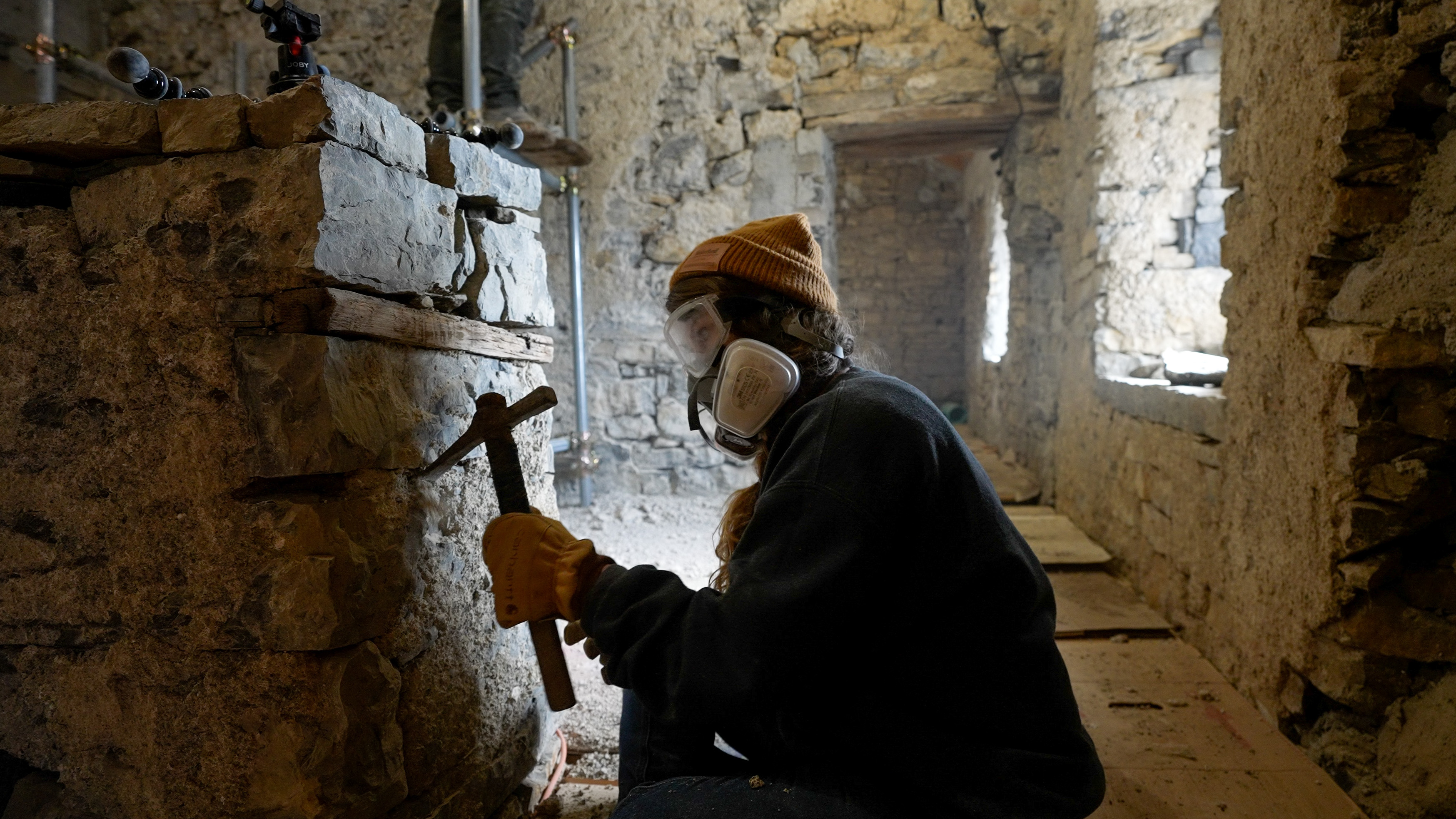
Although Bradey believes it would have been easier to just rent a comfortable, affordable apartment with a view of the mountains, the couple was in love with the idea of breathing life into something that was abandoned and had historical significance.
“There’s so many of these beautiful properties in Italy that deserve to be restored, to shine again, and deserve to be lived in,” Bradey said. “But it takes an incredible amount of work to get them back to a point where you’re legally allowed to live in them.”
Breathing Life Into an Abandoned House
Bradey and Heather began their reconstruction outside by tearing down an old goat fence and using the wood to build an outdoor kitchen. They then erected a tall chestnut wood fence, using wood from a local mill, to keep their daughters safe from the 26-foot drop into the valley below.
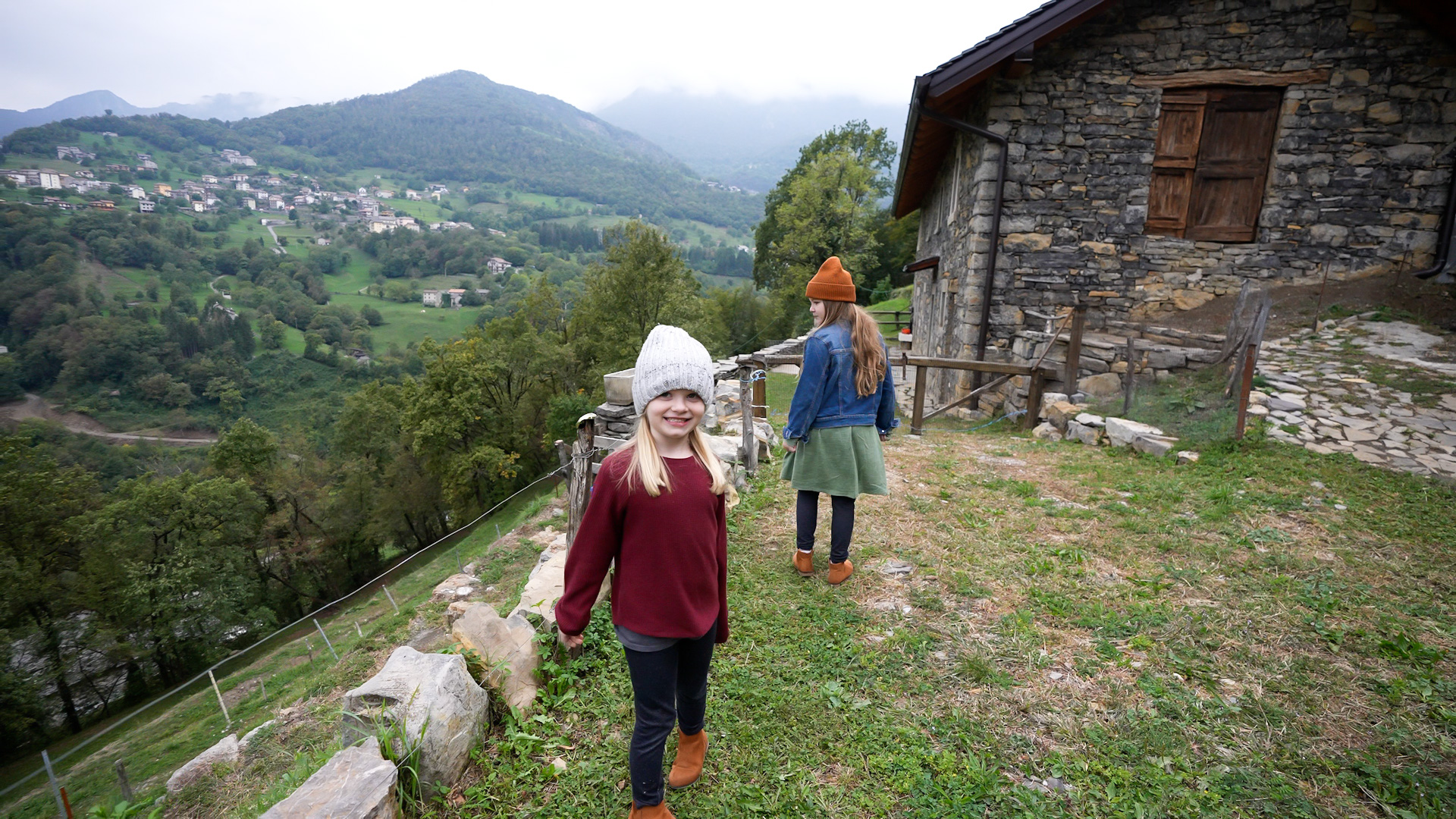
“We’ve been using mostly the materials that we find on the property,” said Bradey, who is living off-site with his family in a rented apartment. “We’ve done a lot of gardening, a lot of building up, and fixing stone walls and stone steps. … We have running water and a cooking stove, and we built a composting toilet, so we have all of the makeshift necessities to be working here full-time. … We just can’t sleep here.”
For the interior, Bradey and Heather have had to start with the heavy work, digging down to 30 inches through solid clay and parts of the mountain using a jackhammer to lay pipes and insulation under the entire ground floor of the property, competing with small boulders weighing as much as approx. 661 pounds (300 kilos).
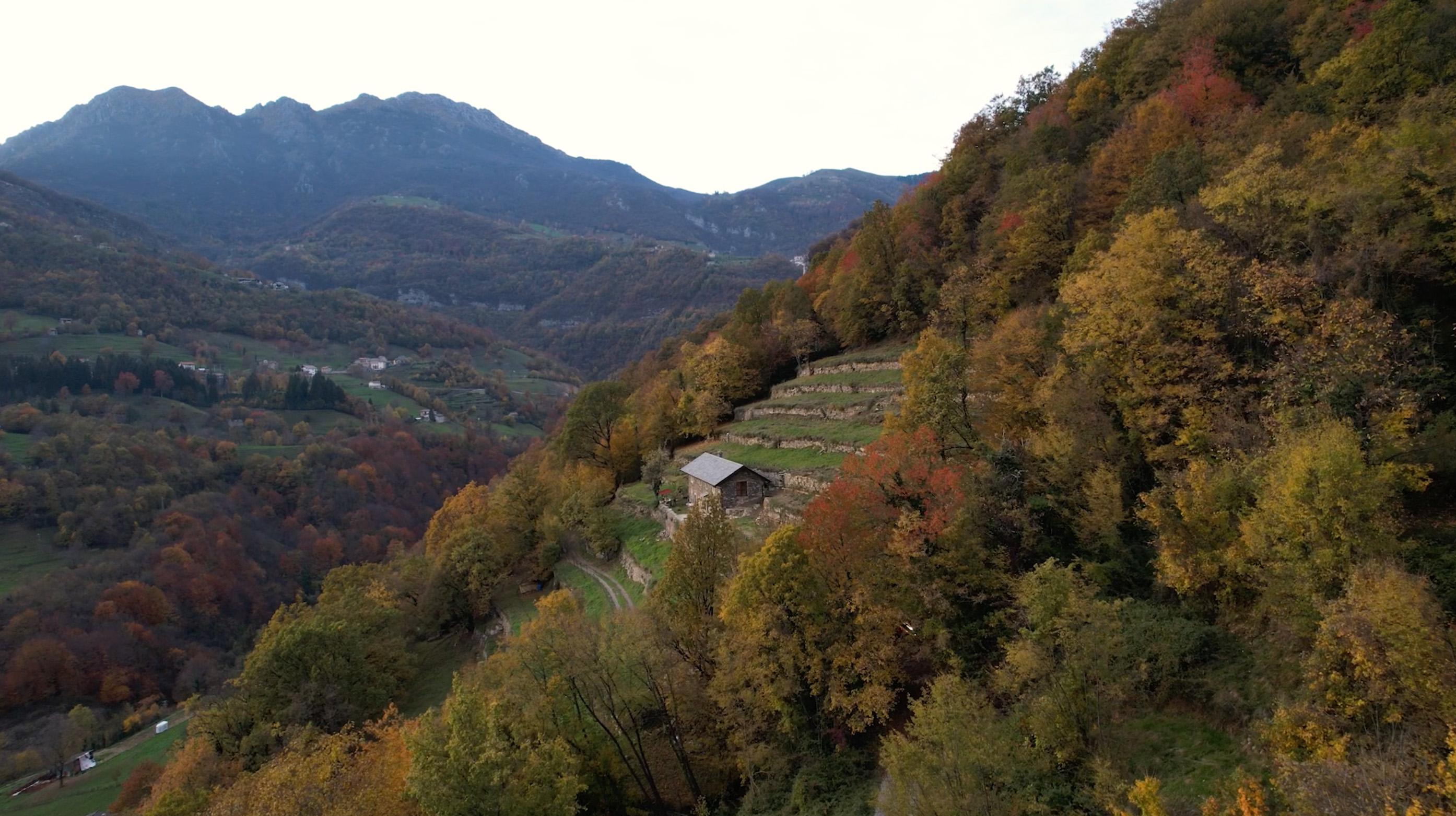
So far, they have also planted a garden and plan to lay enough solar panels on the large roof of the south-facing home to generate all the electricity they’ll need, including for heating, air conditioning, and charging their car, eventually eliminating energy bills completely.
Bradey said the property came with a donkey named Stella, who lived with them for the first few months of the renovation. But since donkeys need other animal companions and the family wasn’t able to provide for her, she was adopted by a neighbor.
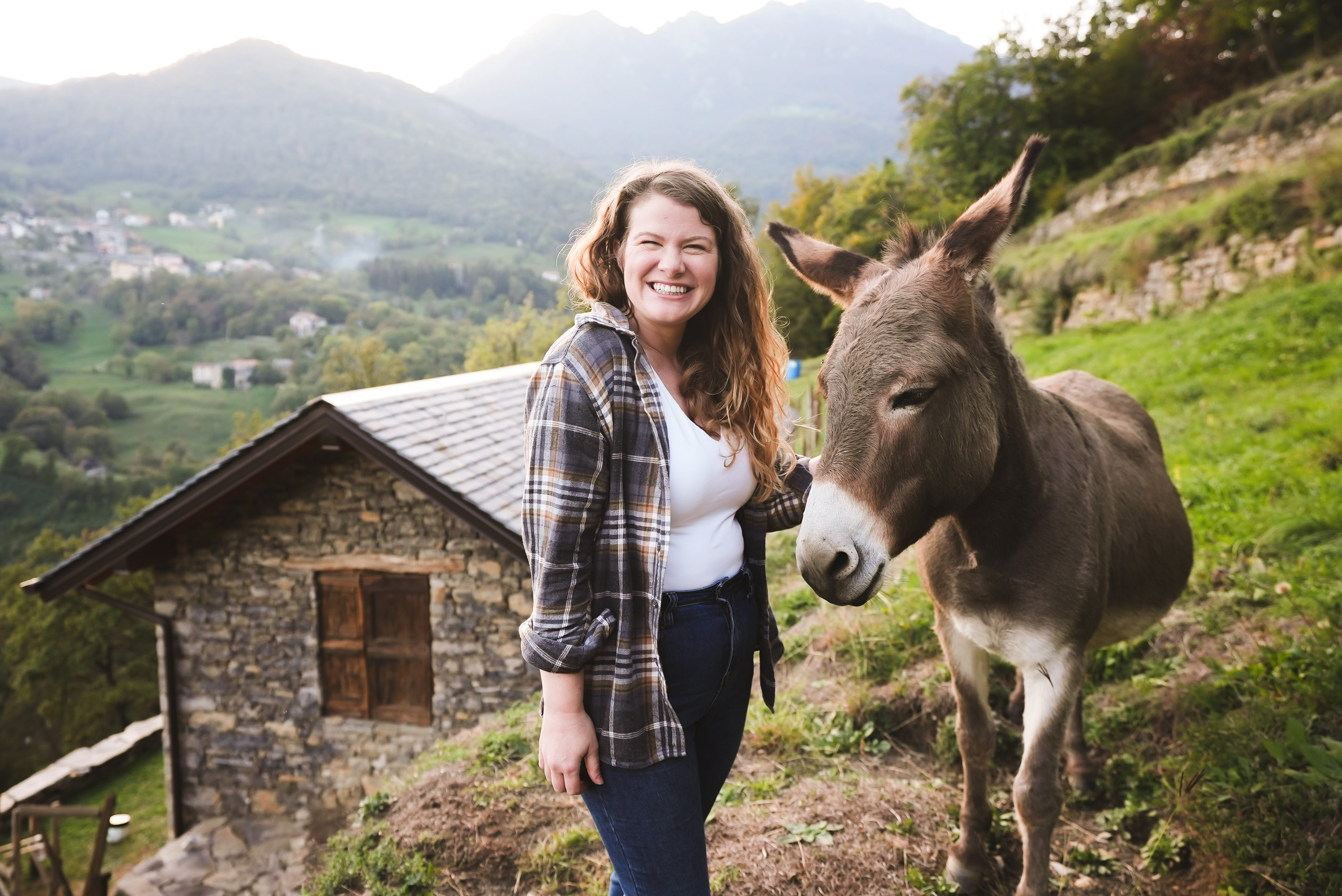
Although the whole renovation is a challenge, Bradey said: “I think that’s part of the reason we’re doing it; we’ve always been drawn to living out of our comfort zone.”
Thriving
Two family members that have readily embraced living outside of their comfort zone are Alexa and Chloe, who get involved in the renovation whenever it’s safe to do so.
“They’ve helped us digging in the foundation a little bit, they’ve helped build the fence. Pretty much every project along the way is not only a chance for us to spend time together, but also a chance to teach them work ethic and how to build things,” Bradey said. “They pick up sticks and stones, and they build the most incredible forts. They’re always building ‘fairy gardens,’ as they call them, and their creativity just comes alive.”
This is one of the reasons the couple has been trying to push their timeline as quickly as possible.
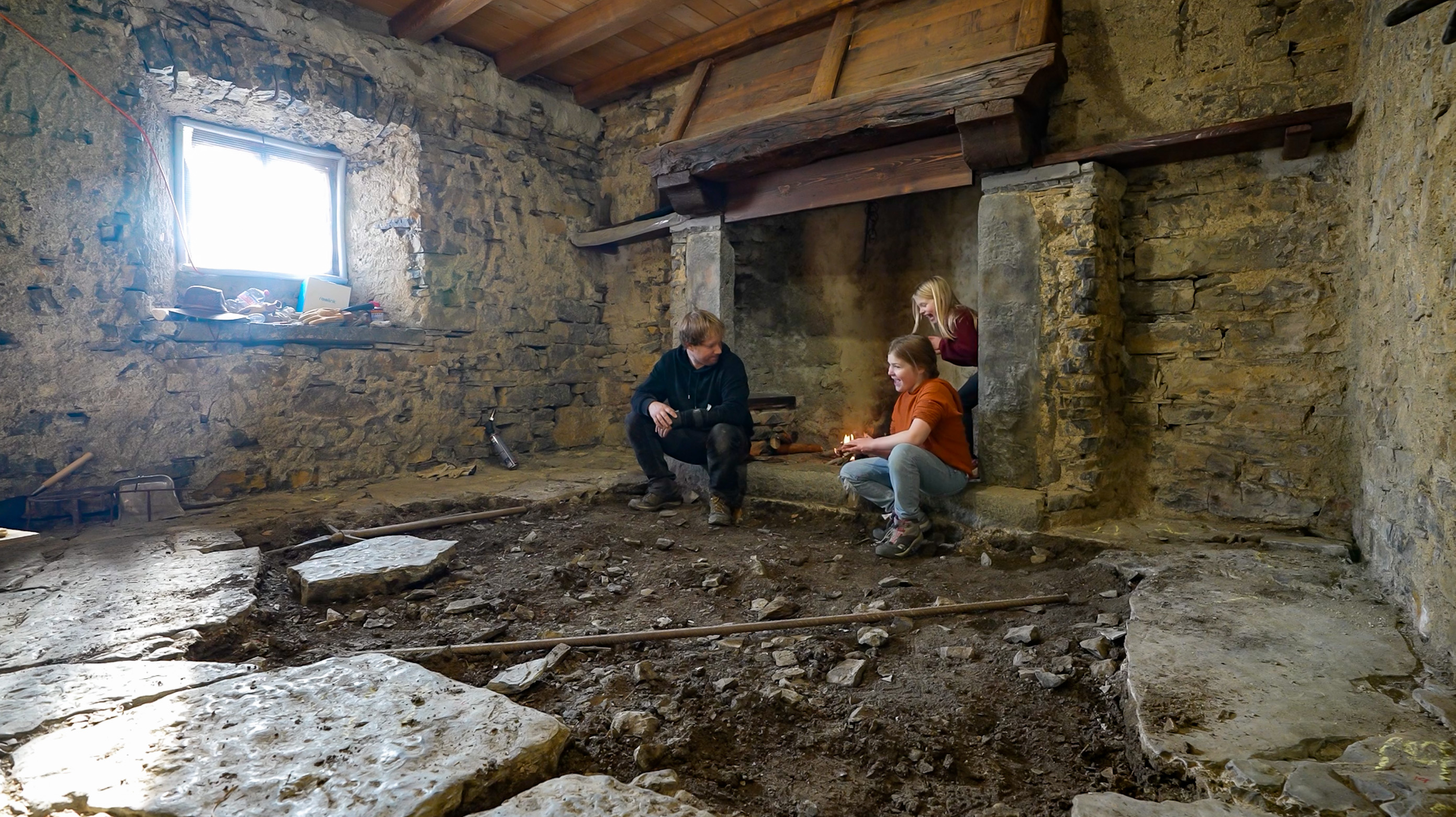
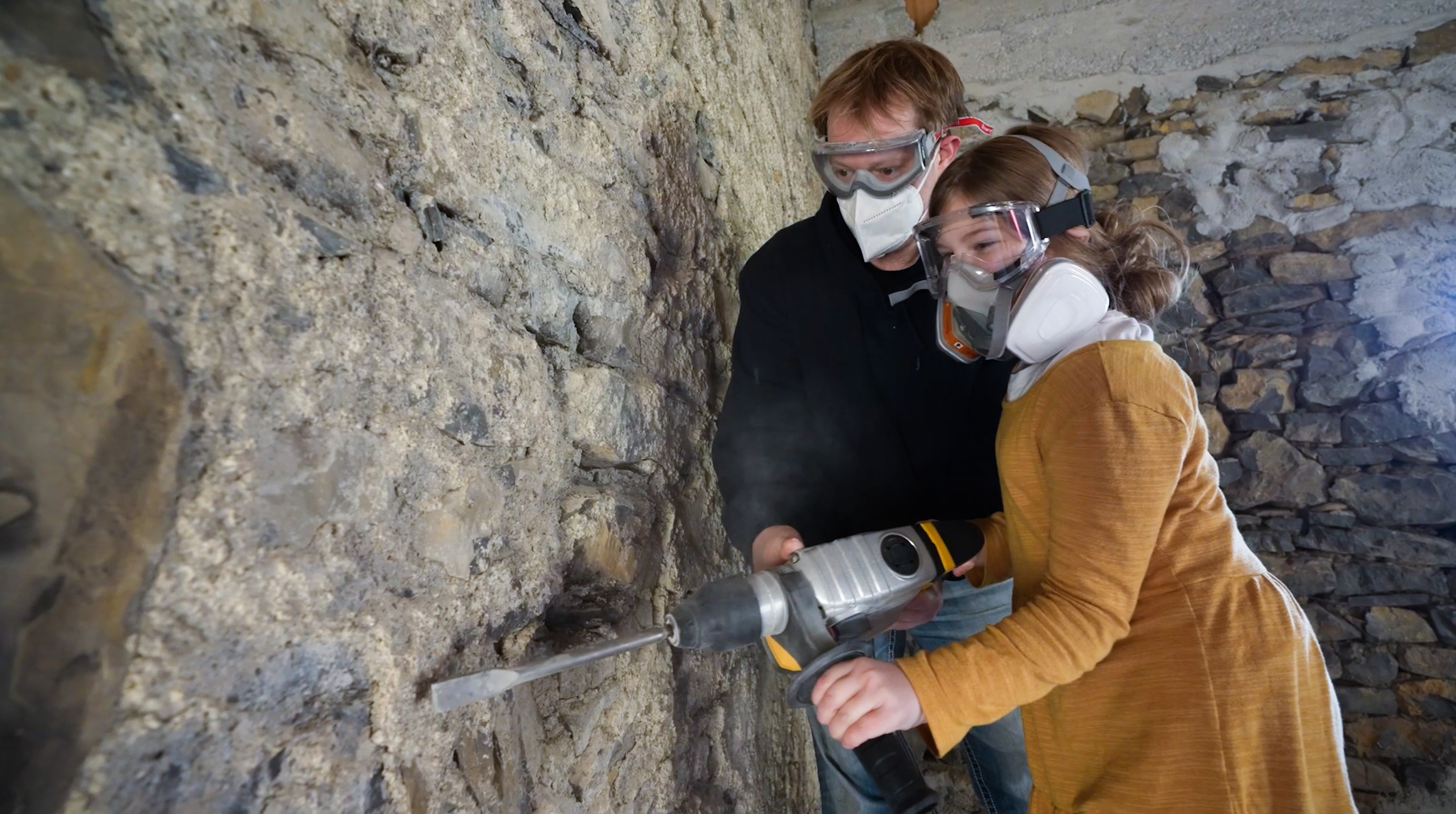
Bradey, who lived in Ukraine between the ages of 9 and 16, knows what it is like to emigrate and was hesitant to move his kids but is proud of their resilience.
“It’s a very painful thing to go through and yet they’ve done incredibly well,” he said. “I’m sure that has to do with the years and years of travel and the fact that this is the first home they’ve had in the last two years. They’re doing so well. They are learning the language, they’re attending school. … They’re thriving.”
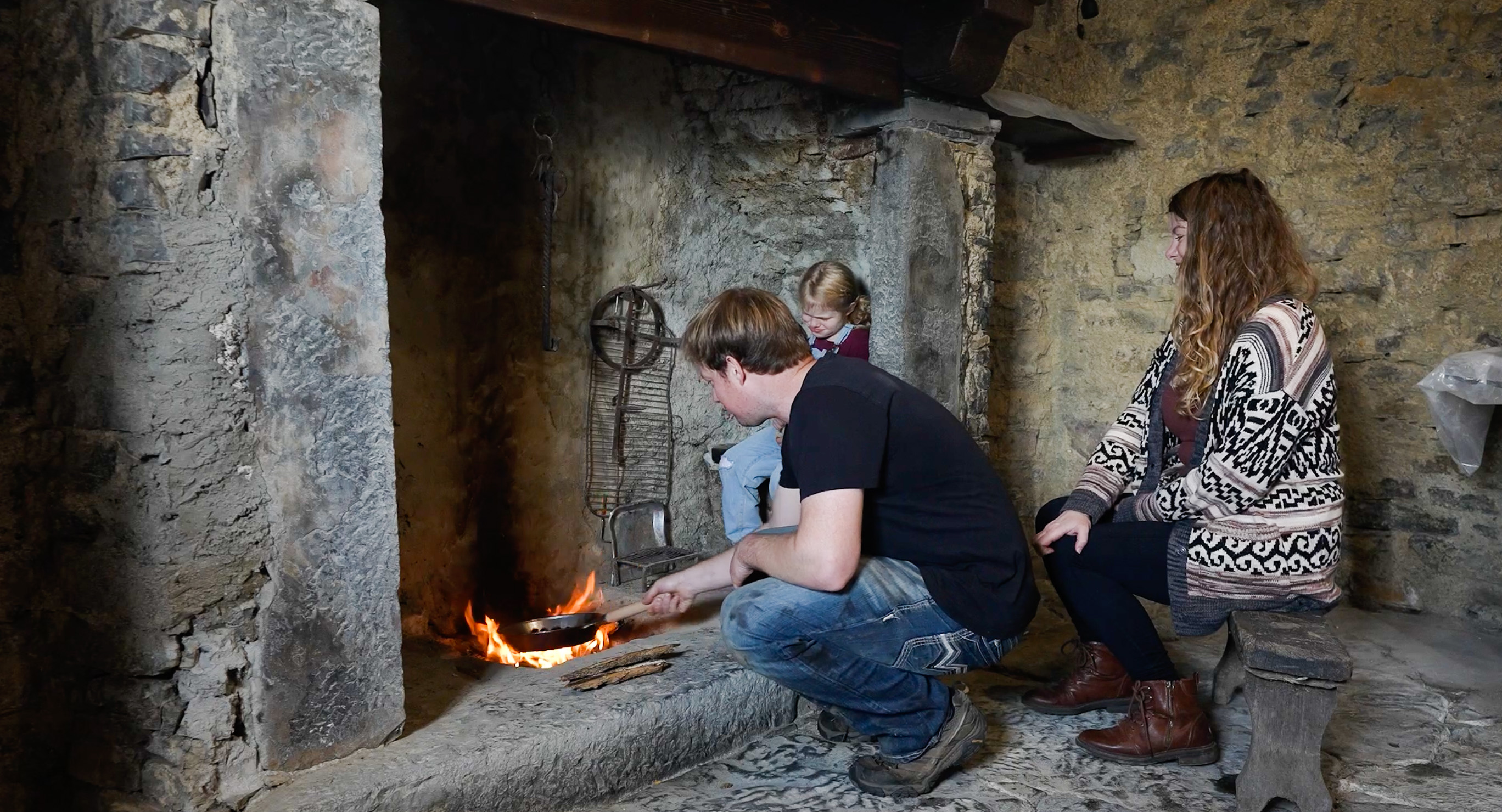
To share their homestead dream with the world and to generate revenue for the renovation, Bradey, who has a background in cinematography, is sharing their progress on YouTube. Their family video blogs chronicle everything from leaving the United States, to their first days at the stone house, to building their outdoor kitchen.
“I want people to know that you can live life outside of a box, that you can write your own story, that you can, what I like to call, ‘reverse engineer’ that finish line,” Bradey said. “10 years ago, we sat down and we scripted out how we wanted our life to look, and every year it changes a little bit. We have worked incredibly hard to get here. But it is possible, no matter what background you come from or what financial position you’re in.”
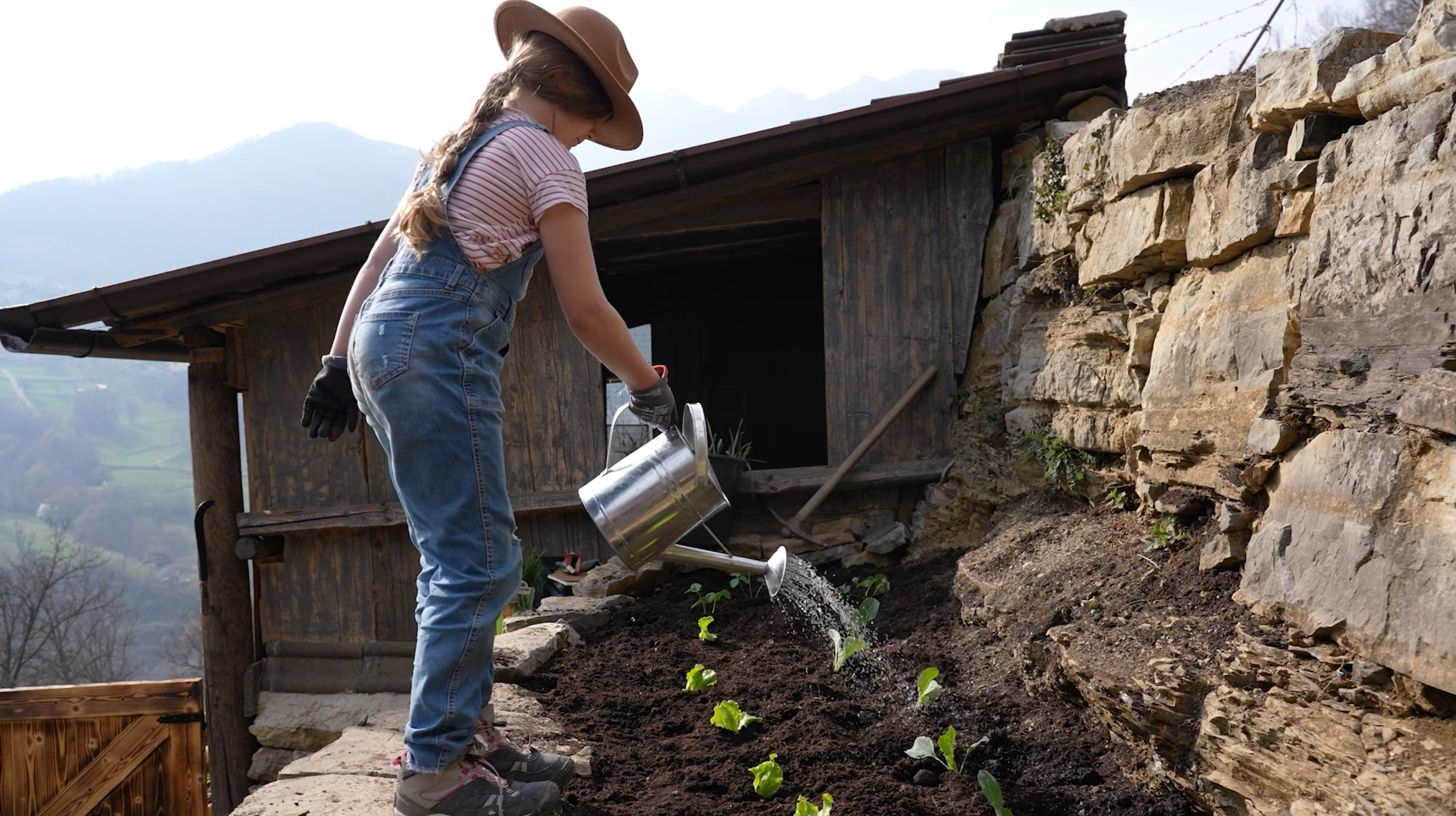
People often ask Bradey if he regrets the decision to relocate his family to Italy to chase their dream. He replies with a resounding, “No.”
“[A]ny time I take a break and you step outside of the work and you look at the view, you’re just flooded with a peace that’s inexplicable. … you come out here and you’re like, ‘Ah, this is why I’m doing this! This is why I’m breaking my back,’” he told The Epoch Times. “It’s hard to explain until you look out at the view, and you listen to the goats off in the distance, and the church bells. … it’s completely worth it.”
Bradey and Heather aim to meet the legal requirements to move into their home in December, after which they will spend another six months finishing the renovation. Their long-term goal is to take their 4 acres of land “back to what it was meant for,” and that’s agriculture.
“We will put in a vineyard, we even plan on putting in an automated greenhouse and being able to grow foods that are not normally grown in this climate, such as avocados,” Bradey said. “Those are plans and dreams for a future year.”
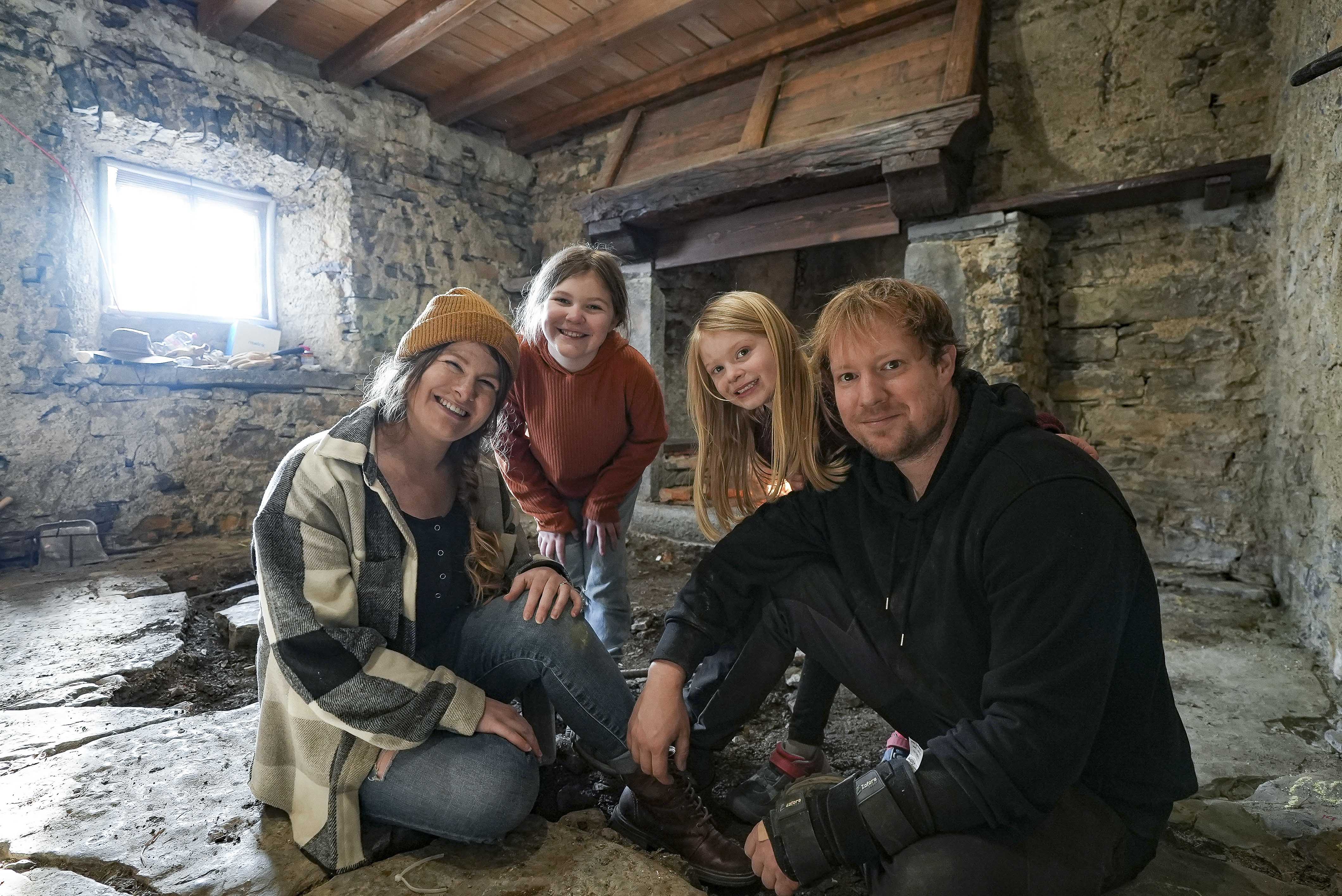
Share your stories with us at [email protected], and continue to get your daily dose of inspiration by signing up for the Inspired newsletter at TheEpochTimes.com/newsletter
Article cross-posted from our premium news partners at The Epoch Times.
]]>I will be posting more articles with more useful tips and tricks. To be fair, I’ve been so busy during election season that I haven’t had much time to work on my own preps, let alone offer tips. But the election is done so it’s time for me to get into it all again, especially considering the election means we’re closer now to whatever might make us use our preps.
For those who are actually considering moving to a safer area, it may behoove you to consider one of our newest sponsors and their amazing bunkers. I covered the article below in a short segment on the latest episode of The JD Rucker Show. Below is the article by J.G. Martinez at The Organic Prepper.
Most of us are not exactly farmers and will have a hard time growing or raising what we intend to eat if we just one day decide to start living off our harvests. It is a fact. Hunters and fishers obviously will have an edge after the collapse, but sadly, I am almost sure that in a tribal environment, my social position would not be too high.
That said, maybe joining a tribe after some age won’t be as romantic as it seems. Maybe a better idea, in order to live longer, is to stay low profile and semi-hidden, with only a few close friends and family nearby. At some age, you need some peace.
For many old-school survivalists of times already gone, the proper approach was a complete farm. The amount of work involved with this path is plenty.
The more land you have to take care of, the more problems!
I’ve seen this a few times. Hard-working people who made a few bucks with three or four crops in a row expanded their business by buying another farm somewhere else, and…bang!
With twice the land, their problems multiplied exponentially, and the need for further investment followed.
However, maybe for many of us, the ideal location is not a full-size homestead or a large compound.
A micro-retreat may be the solution.

The word “micro” suggests that something minimal should come to mind. My technical background immediately clicks when I think about anything related to a production facility, and I imagine a highly productive but compact environment.
I have always been fascinated by those overlanders’ custom-built rigs over a Mercedes Unimog chassis. They are compact and space-efficient but comfortable enough for prolonged stays. This is a remarkable example of a well-done micro-habitat.

Also, think about the tiny house movement. Some of those properties are designed for boondocking – living away from civilization and services. (Want to know how to keep your family fed when you have to use a micro-retreat? Check out our free QUICKSTART Guide to building a 3-layer food storage system.)
A micro-retreat doesn’t have to be a micro-producer.
Depending on your family group, or whatever the flavor of “clan” you may have, you could craft a small place quite productive with proper planning, provided you know your climate and your skill level. You could even disguise it as a “vacation” property. The beauty of this is that nobody has to know that your gun safe is in a hidden portion of the basement in your “hunting cabin.” Or, nobody has to know that those PVC DIY empty shelves in your basement will be to grow microgreens to complement your food supply.
Such planning will make your life easier. There will be less investment to make, you will work smarter and not harder (something that will make your senior years more pleasant!), and generally, it will be much easier to keep your place clean and well-maintained.
A “micro-retreat” doesn’t mean you have to restrict yourself to the bare minimum land for your needs.
A plague could attack your crops. Someone could arrive unexpectedly, and you will need some extra. The ideal setup would be a place secluded enough, but where unexpected visitors will be able to stay, if needed.
As an example, you could think of a small greenhouse. You must think in terms of vertical expansion (upwards and downwards)if you want to keep the initial cost of a micro-retreat low enough and to maximize the space. I like to think the positive part of a small setup is that it will be much easier to keep hidden. Planting thorny bushes around will make it inextricable in a few years and will hide your orchard, gardens, and buildings. You may combine this with earthbag DIY construction that you can cover with dirt and some weed or grass grows over an ingenious layout, and it will be almost undetectable.
You may want it as a semi-permanent, permanent, or temporary residence.
The size will depend on what you want, what you need, and what you can afford. That’s the compromise.
Planning includes thinking thoroughly and drawing a sketch with the layout you believe you’re going to need. By dividing your needs into sections, or compartments, you will make sure it will be easier to make a much more complete analysis of what you need.
You need to know what is next to you!
Neighbors? A cliff?
A mountainside that could generate a mudslide? A lake? A river that could flood your place under several days of heavy rains? Hunting/fishing areas? And, by extension, you need to know what you don’t want nearby!
Try to keep things at a proper size using scaling.
What I like about the concept of a micro-retreat is that you don’t need too much space if you are on your own or have a small family. However, having space outdoors will be a big deal, even if your bedroom is a bunk bed on top of a study or desktop. And, if you build an area to hang out, even better.
You may want to use some advice from those who are professionals at living in small spaces.
Use vertical space.
You may even think on three levels, provided you’re in a place with plenty of sunlight:
- Level 1: A terrace with a pergola on top. Place solar panels here for Level 3. Have planters all around with spices or flowers. This level could double as a place to drink coffee, have dinner, or hang out. Or work as a watchtower. Make it easy to access with round stairs. Build it pretty, and make sure the water collected by this roof is collected.
- Level 2: Maybe some tanks for tilapia or more plants that don’t need too much sun? Perhaps you may want to start the microgreens growing at this level?. A secondary walk-in pantry? Materials storage, like plumbing, wiring, and car spare parts? Your woodworking shop? Butcher room? Smoker/dry food storage?
- Level 3: This is a basement.
(Want uninterrupted access to The Organic Prepper? Check out our paid-subscription newsletter.)
Here are a few final thoughts of mine on micro-retreats…
LED grow lights, a small pump for the water/nutrition solution mixture, and shelves with the greens will improve your capabilities to produce highly nutritive vegetables in a reduced space. You don’t need to dig too much. Just do good research on this topic.
Even better, if you can afford more than one, isn’t it always a good idea to have some redundancy in your survival assets? Why not build yet another micro-retreat in a place further away, just in case, then?
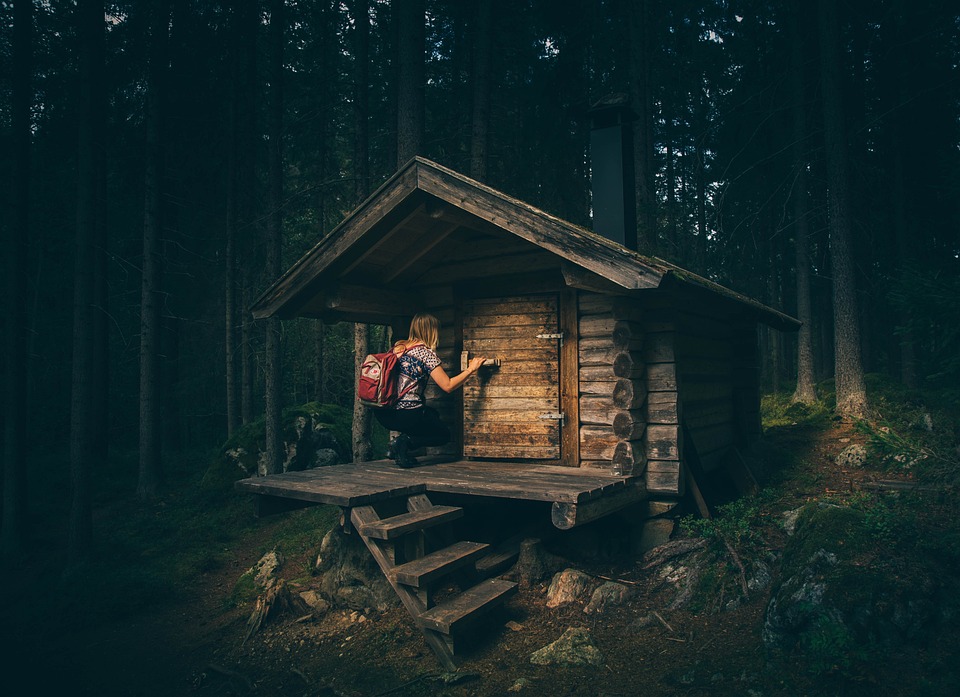
You don’t have to “think big.” Especially if the economy forced you to do with what you have.
Wise use of small spaces can be a challenge but very rewarding in the end as well. Let us know what you think in the comment section below and keep tuned for more!
Have you considered a micro-retreat?
What do you think about going small-scale for survival? Have you thought about downsizing instead of creating bigger and more elaborate plans? What do you see as the pros and cons?
Let’s discuss the concept of micro-retreats.
About Jose
Jose is an upper middle class professional. He is a former worker of the oil state company with a Bachelor’s degree from one of the best national Universities. He has an old but in good shape SUV, a good 150 square meters house in a nice neighborhood, in a small but (formerly) prosperous city with two middle size malls. Jose is a prepper and shares his eyewitness accounts and survival stories from the collapse of his beloved Venezuela. Jose and his younger kid are currently back in Venezuela, after the intention of setting up a new life in another country didn’t go well. The SARSCOV2 re-shaped the labor market and South American economy so he decided to give it a try to homestead in the mountains, and make a living as best as possible. But this time in his own land, and surrounded by family, friends and acquaintances, with all the gear and equipment collected, as the initial plan was.
Follow Jose on YouTube and gain access to his exclusive content on Patreon. Donations: paypal.me/JoseM151
]]>Some time ago, I came across an article entitled “Former Military Bunkers Are Home for Hundreds of Survival-Minded People.”
It seems a development group called Vivos (which develops survival properties in various places around the world) has purchased a huge property containing 575 former military bunkers near the Black Hills of South Dakota. “The 7,000-acre development sits on the former Black Hills Army Base, built in 1942 by the Army Corps of Engineers to store bombs and other munitions during World War II,” says the article. “The Army retired the base in 1967 and sold the property and all 575 bunkers to the city of Edgemont, which, in turn, sold it to local cattle ranchers.”
The massive concrete structures are being turned into bunkers for survivalists.
There’s certainly something to be said for these structures. The location is geographically isolated and seismically stable. The bunkers themselves are spacious (2,200 square feet) and the thick concrete walls are constructed to withstand both internal and external blasts, such as that of a nuclear bomb. Each unit can be custom outfitted in luxury, with the primary disadvantage being the lack of natural light.

According to the website, “Each bunker provides enough floor area, with attic potential, to comfortably accommodate 10 to 24 people and their needed supplies, for a year or more, of autonomous shelterization without needing to emerge outside.”
These bunkers are made to last. “Each bunker includes a massive existing concrete and steel blast door, that seals to stop any water, air or gas permeation; air and exhaust ventilation shafts, and a secondary emergency exit. … This elliptical shape mitigates a surface blast wave, as well as radioactive fallout due to the thickness of the overburden of soil and concrete.”
I got curious about this development and did a little research. I’ve come to the conclusion the whole project is, well, stupid. Well, maybe not stupid so much as misguided.
From sociopolitical commentary to romance writing! Patrice Lewis branches into the world of Amish inspirational fiction. These clean romances are wholesome enough for Grandma to read. Check out Patrice’s available titles.
Why? Because as I see it, literally the only advantages of these bunkers is their ability to withstand the types of explosions and blasts for which they were constructed. But as prepper shelters, they have less appeal – unless, literally, your only concern about the future is nuclear warfare (which, to be fair, is a legitimate concern considering the situation in Europe).
There are, in my opinion, a number of strikes against these bunkers:
- Customers pay a lot, but not for ownership. According to the article, “It costs $45,000 to purchase a 99-year lease for each bunker and about $150,000 to $200,000 to convert it to living quarters.” The website clarifies, “There is a one-time upfront payment of $45,000, plus an ongoing annual ground rent of $1,091 per bunker. Bunkers are provided in their as-is condition, without interior improvements, equipment or furnishings, ready for your outfitting.” That’s a lot of money for an unfinished rental.

- Alternately, customers can pay $15,000 to secure a space in a shared bunker. These are “completely furnished, outfitted, stocked with 1 year of food and supplies, dishware, linens, fuel, water, and bedding, with a deluxe private bunk with keyed access. Perfect for singles, couples and small families to share with others.”
- The facilities are still dependent on outside power sources (fuels for generators, etc.). According to the FAQs, “The entire bunker network is off grid, without power supply from the local utilities. Each bunker needs to install a diesel generator with 55-gallon drum fuel storage tanks for the primary ongoing power requirements.” With the unfolding energy crisis on both the national and international stage, this strikes me as an enormous vulnerability.
- There is no private water source. The FAQs specify, “Vivos distributes water from our 4,200-foot-deep aquifer well up to a 250,000+/- gallon underground cistern located on a hill within the complex. Water is then gravity fed to each bunker. The initial water line hookup to each bunker is just $3,000. Thereafter, you may freely use as much water as you like, for inside shelterization purposes, at no extra charge, provided you are not wasting the water.” However presumably it requires fuel to lift the water from a depth of 4,200 feet. What happens when the fuel runs out?
- Property “per bunker” is limited to 30 feet from the structure. This limits the amount of space to build any structures such as barns or other livestock facilities – much less have grazing room for animals. Some customers have planted gardens on top of their bunkers, which is probably the very best location for a garden; but additional self-sufficiency options (such as room to house and graze cattle) are limited.
- The USDA Hardiness Zone for the area is 4B, same as most of Alaska. This means gardening is challenging. The hardy people who already live in this region have years of experience in dealing with the climate and have a thorough understanding of what plants will grow and what won’t. How long will it take newcomers to the area to acquire that same knowledge? More than one growing season, I suspect.
- Essentially, these bunkers are like self-imposed prison cells. Someone could literally trap you inside by bulldozing a huge load of dirt or rocks in front of the bunker doors. Alternately, you could be forced out by Bad Guys cutting your water and/or power lines.
In short, it strikes me that these bunkers appeal mostly to the “Gee this is cool!” school of thinking, rather than the hard reality of what it takes to survive a bleep-hit-the-fan scenario … unless, of course, the “bleep” is a nuclear holocaust.
And even then, these bunkers have a limited attraction (to me, at least) in the event of a nuclear war. Sure, they’ll do a splendid job of protecting you for as long as you stay within their thick concrete walls. But what then?
Let’s put it this way: If outside conditions are so dire that you must literally hole up for an entire year, then things will be positively apocalyptic when you finally emerge from your concrete cocoon. Let’s say nuclear Armageddon happens and you’ve survived, thanks to your remarkable bunker. A year has passed, and you emerge, blinking in the bleary sunshine, and realize you have no fuel for generators or water pumps. Presumably by then your food will be eaten up as well. What’s your next step? Ordering something from Amazon?
If people who can afford these bunkers simply want the novelty of living inside a concrete shell, then what the heck, go for it. But they must recognize they are, in many ways, just as susceptible to societal disruptions of goods and services (notably fuel to power generators and well pumps) as anyone else.
Or am I the misguided one here? Am I missing something? Are these bunkers the best thing since sliced bread? What are your thoughts?
Content created by the WND News Center is available for re-publication without charge to any eligible news publisher that can provide a large audience. For licensing opportunities of our original content, please contact [email protected].
]]>Article cross-posted from our premium news partners at The Epoch Times.
At the time of the storm, Yves and Velvet Rollin were living in Guelph, Ontario. They were not directly affected, but they quickly realized just how helpless they would have been had their power been cut for any length of time. Although they had a wood stove in their home, it was inaccessible in a basement rental apartment.
“It was a wake-up call,” said Velvet. The couple was already thinking about moving to the countryside, and was interested in alternative housing and being more self-sufficient. The ice storm propelled them to make a radical and adventurous decision. In 1999, they bought a 40-acre property in Bruce County, Ontario that had no electricity, and started planning a self-built, off-grid home.
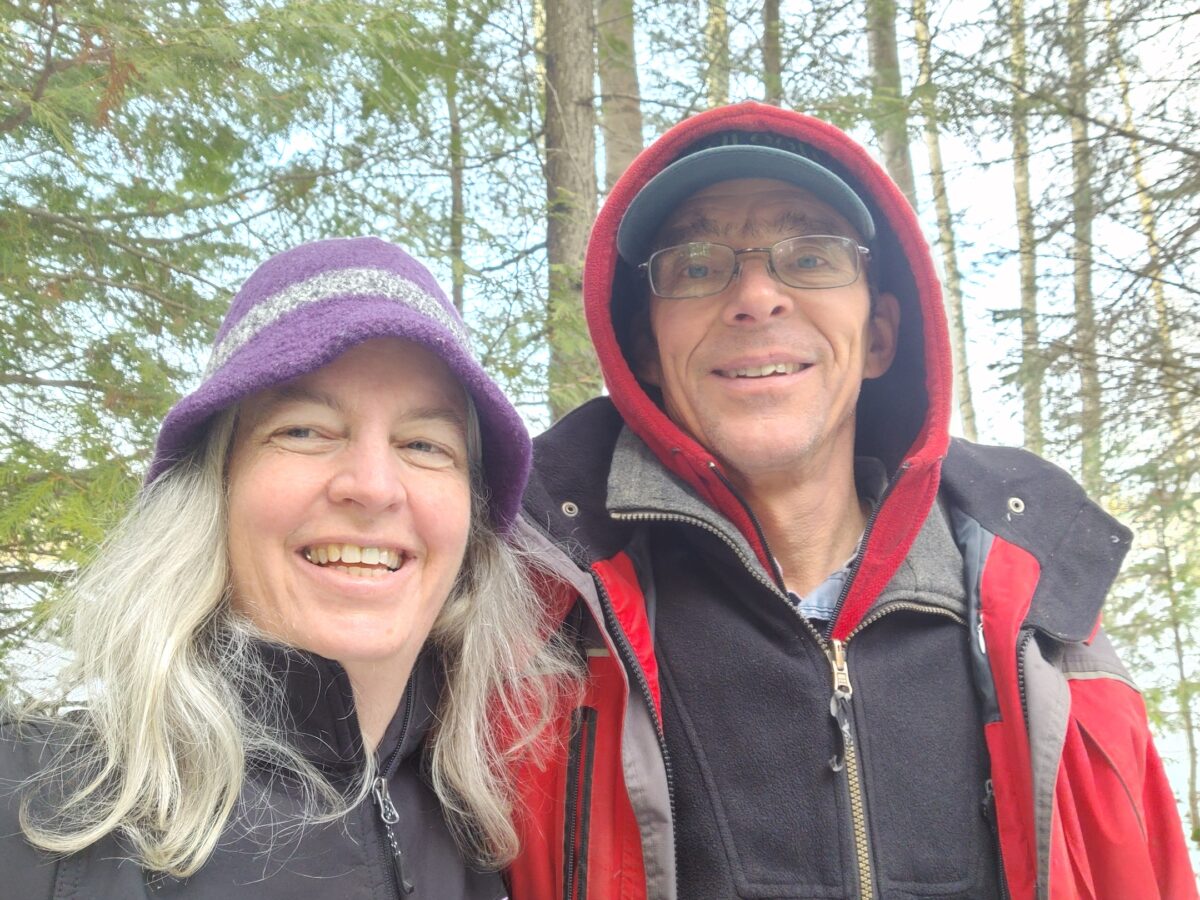
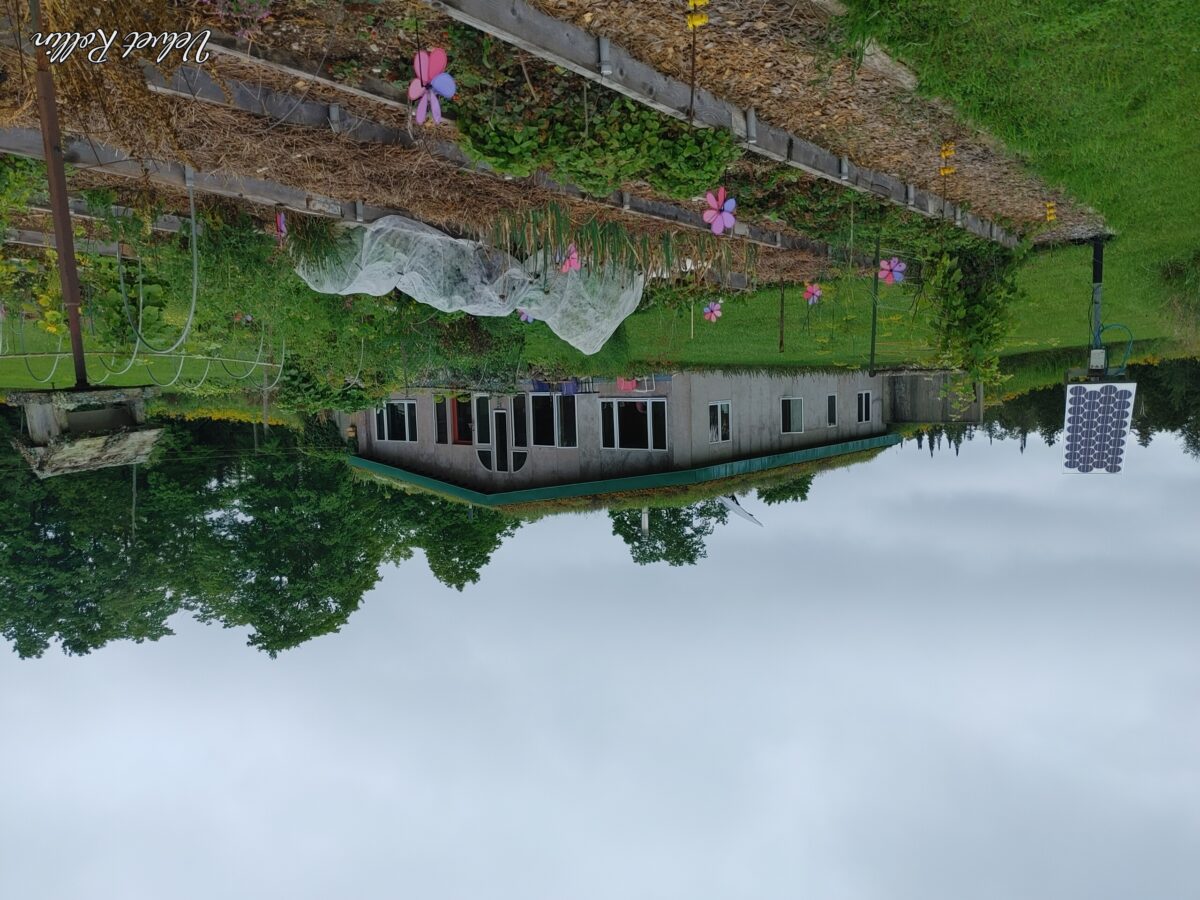
Powering Up
“Living off-grid means you’re not tied into the power system, so you have to rely on your own power generation,” explained Velvet. That means, Yves added, “You have to be willing to make some choices. It means modifying your behavior. We don’t have a fridge; we do have a microwave, but we only use it in the summertime when it’s really sunny. We don’t have a clothes dryer.”
They bought a trailer and moved onto the property with their two sons, aged 5 and 6. “That summer in the trailer was the best summer ever,” said Velvet. They lived in the trailer from 2000 to 2002, using materials for the prospective house to insulate the trailer in the winter. Camping on the property was educational for them as well: “We thought we were going to go all solar. That first winter, there were only eight full-sun days, and we knew that we could not do all solar power.”
Yves and Velvet use a combination of wind and solar power. They have a 1-kilowatt turbine, so small that it isn’t sold anymore, Velvet said. It doesn’t produce a lot of power, and it doesn’t save power, though it can be used to charge batteries.
“The advantage of a wind turbine is it can run 24 hours a day,” Velvet said. “Any stormy weather is awesome for us. In the winter, we’d see how strong the wind was and be like, ‘Yes! We can run whatever we want tonight! We can watch a movie!’”

Over the years, solar panels have become a lot cheaper, and they now have 10 solar panels, producing about two kilowatts. “On a sunny summer day, we have to turn some of them off,” said Yves. “Too much power can overload the batteries.”
The batteries allow them to run the basics if they go for two or three days without power. “We live in such a way that we can easily cut back,” said Velvet. “We use a blender most days; if it’s a low power day, we don’t. We just adjust our power usage based on the weather. It’s a pretty cool way to live.”
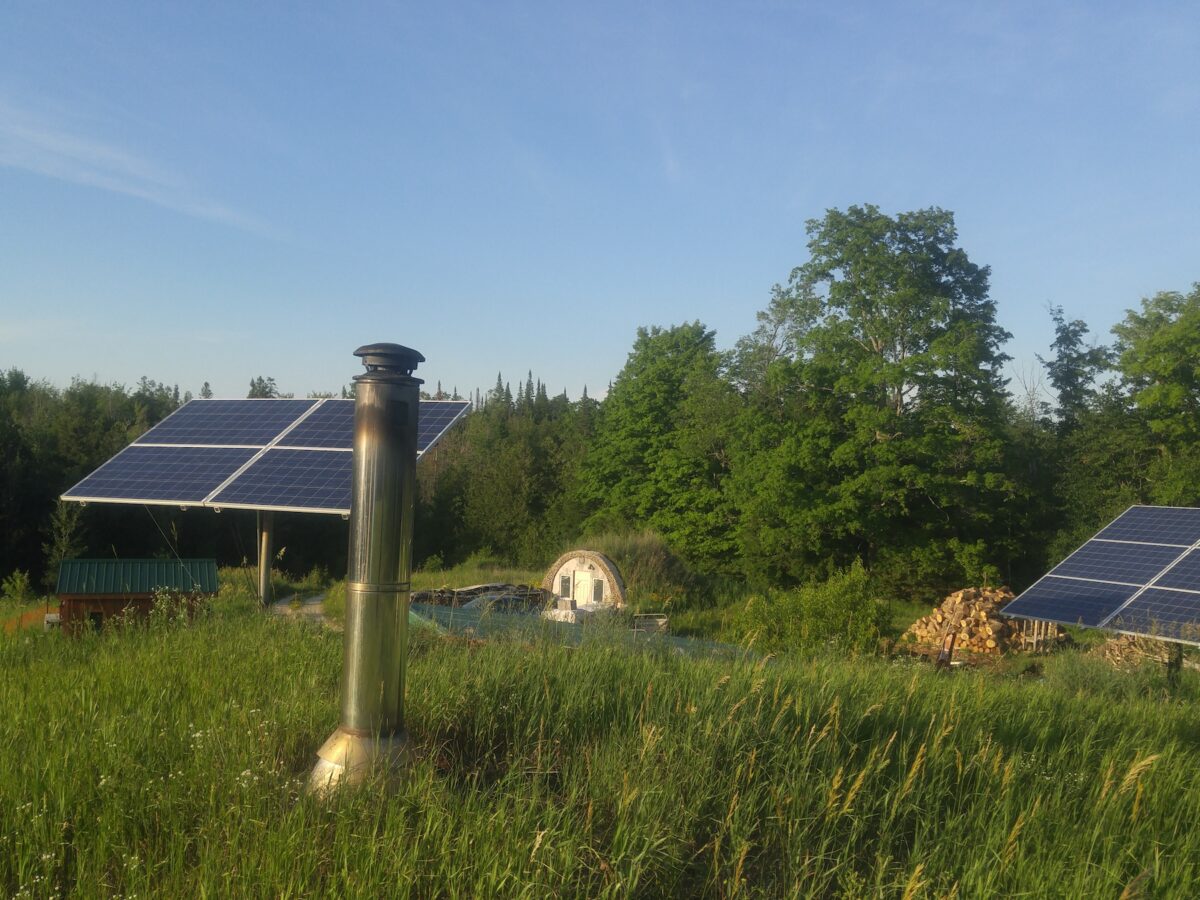
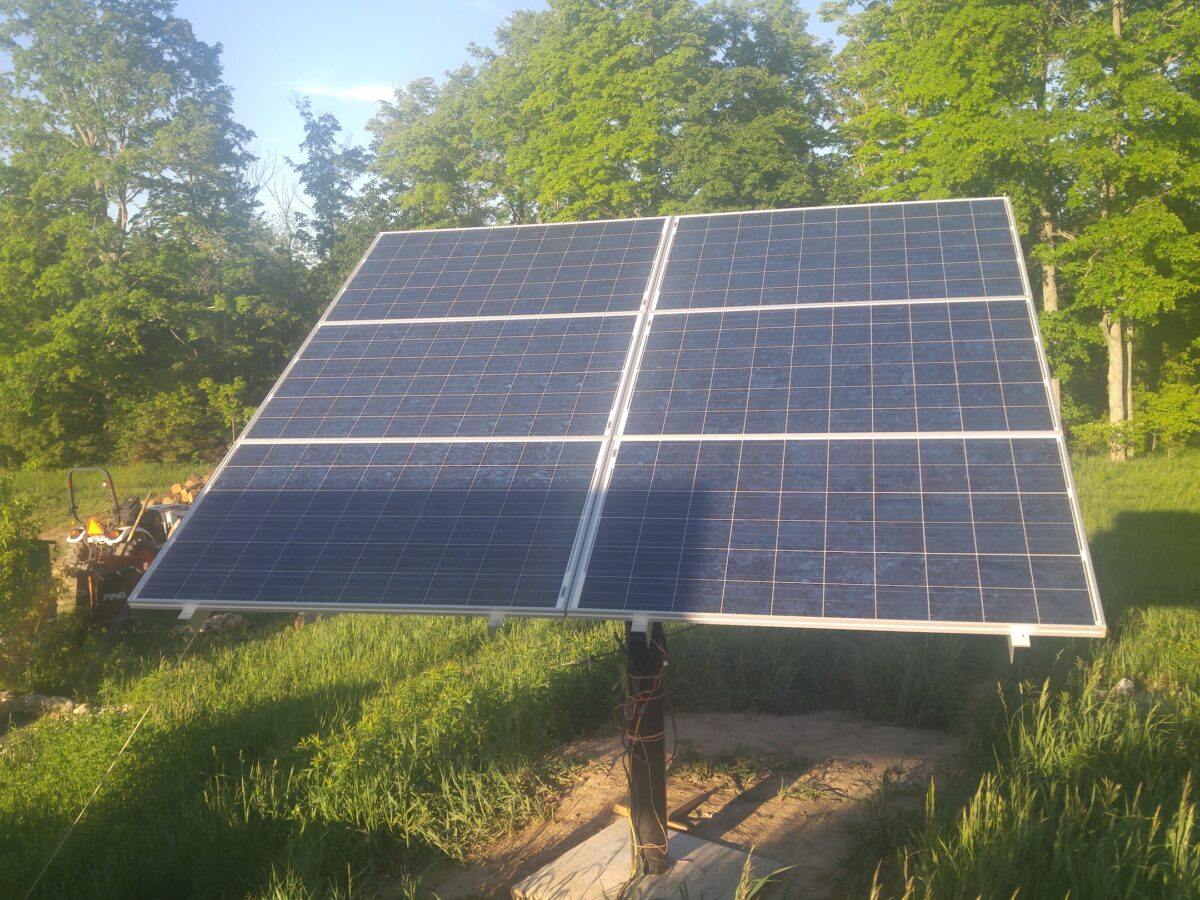
The fridge was the “‘make it or break it device,” according to Yves, when they decided to go off-grid. They had three choices: Buy $20,000 worth of solar panels to provide enough power to run a fridge (based on the cost at the time, in 2002), buy a $6,000 propane-fueled one that would have to be vented through the roof, or live without one.
“We have an ice-box instead,” said Velvet. “At the time you could buy ice blocks for $2.50, and we needed them from April until the end of October. I was working and driving through town each day, so we didn’t need to worry about storing meat; I bought meat the day we were going to cook it. We stored milk, cheese, and things like that.”
They still don’t have a fridge, but they did recently get a freezer. Freezers use less power now, and the Rollins have enough power in their finished home to run one. Ice blocks are less reliably available to buy, so Velvet makes ice in the freezer and also uses it for storing other goods. The ice box lives in the root cellar, which stays just above freezing in the winter and does not get warmer than 64 degrees in summer.
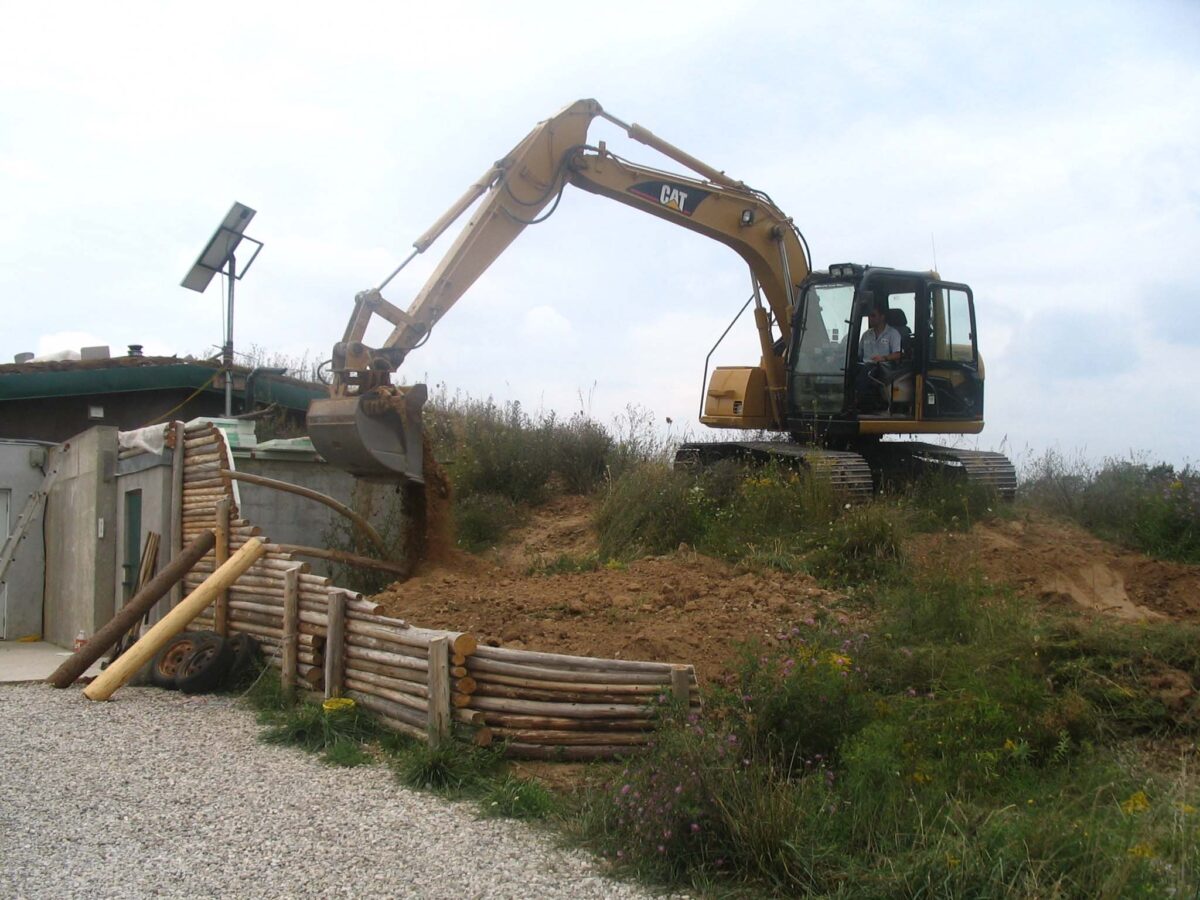
Gardening and Food Storage
Velvet is a food storing and canning expert, and she grows a large vegetable garden each year to help with their annual supplies. She and Yves had a garden when they lived in the city, so they knew a bit about growing vegetables before they started their off-grid adventure.
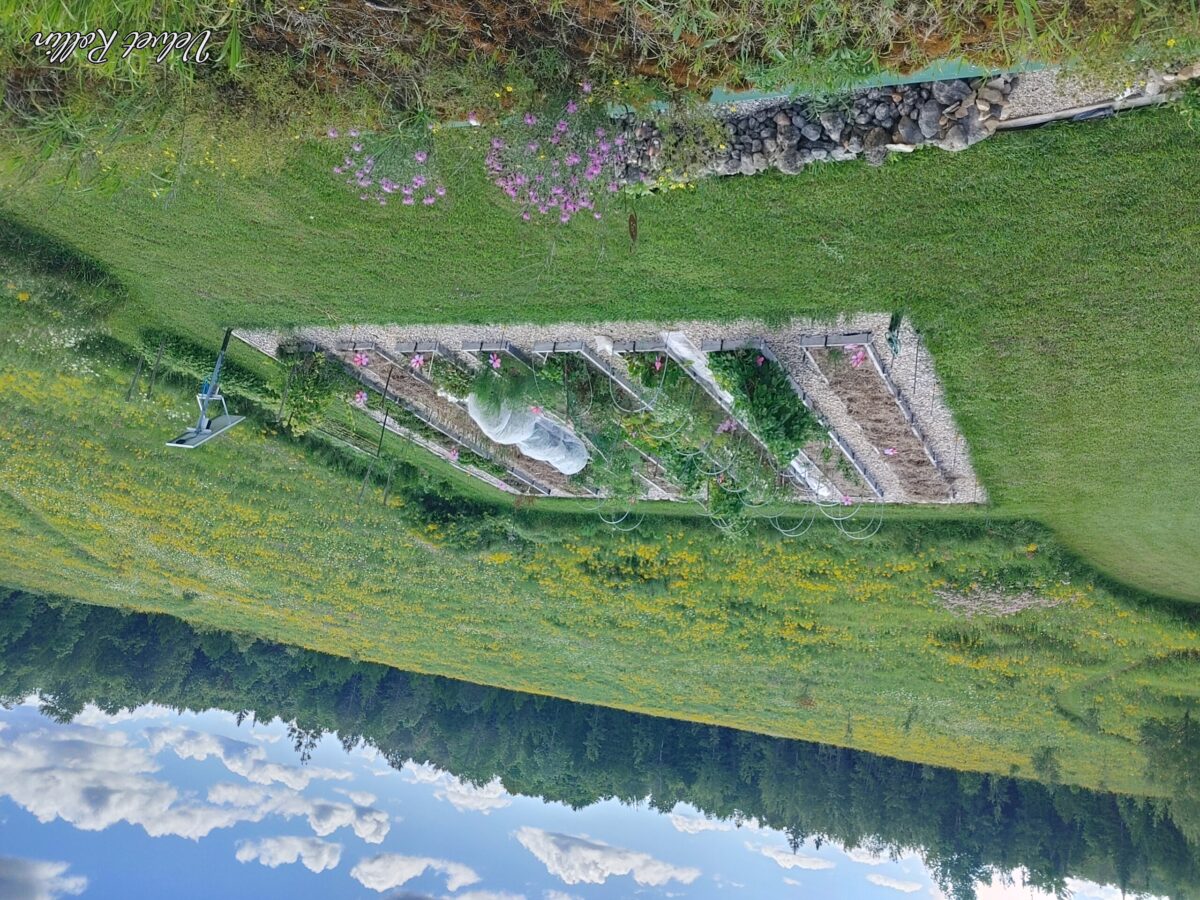
Velvet read in a Country Living book that the best thing you can do when breaking new ground for a garden is to have pigs on the land the year before you start. On her off-grid property, her garden is 40-by-46 feet, and she had four piglets on that spot.
“They did a lovely job of the ground, and their little hooves loosened it up as well,” she said. The key, she said, is to not feed the pigs any supplemental food, but to let them root around and dig up all the roots that have been growing there for years.
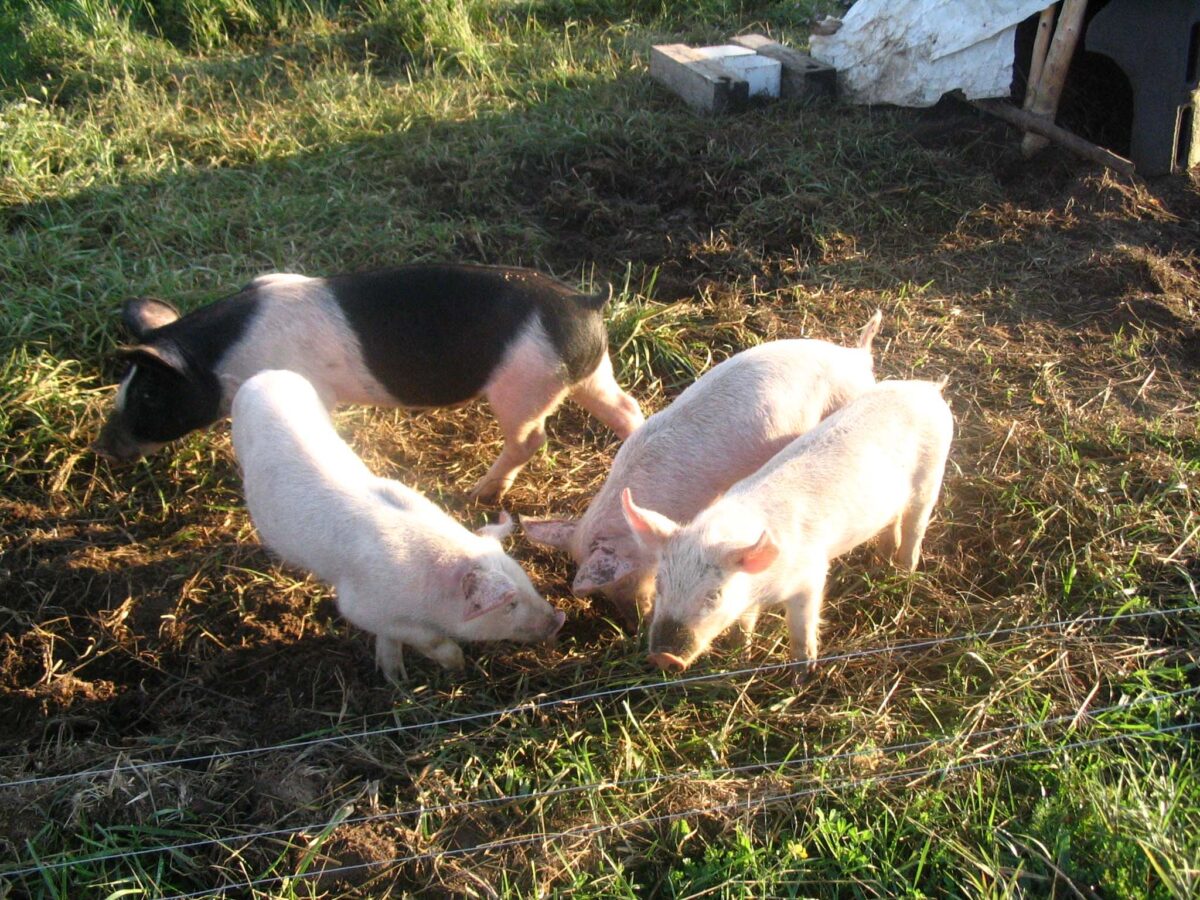
The Rollins have eight rows of raised beds, and they conservatively estimate that their growing season is reliable between June 6 and September 1. She rotates her crops annually to give the soil a break, and she enthusiastically preserves as much as she can.
Her goal is to have one year’s worth of food storage. When the children were younger, a fun adventure was to send them “shopping” in the storage room to find ingredients for a meal.
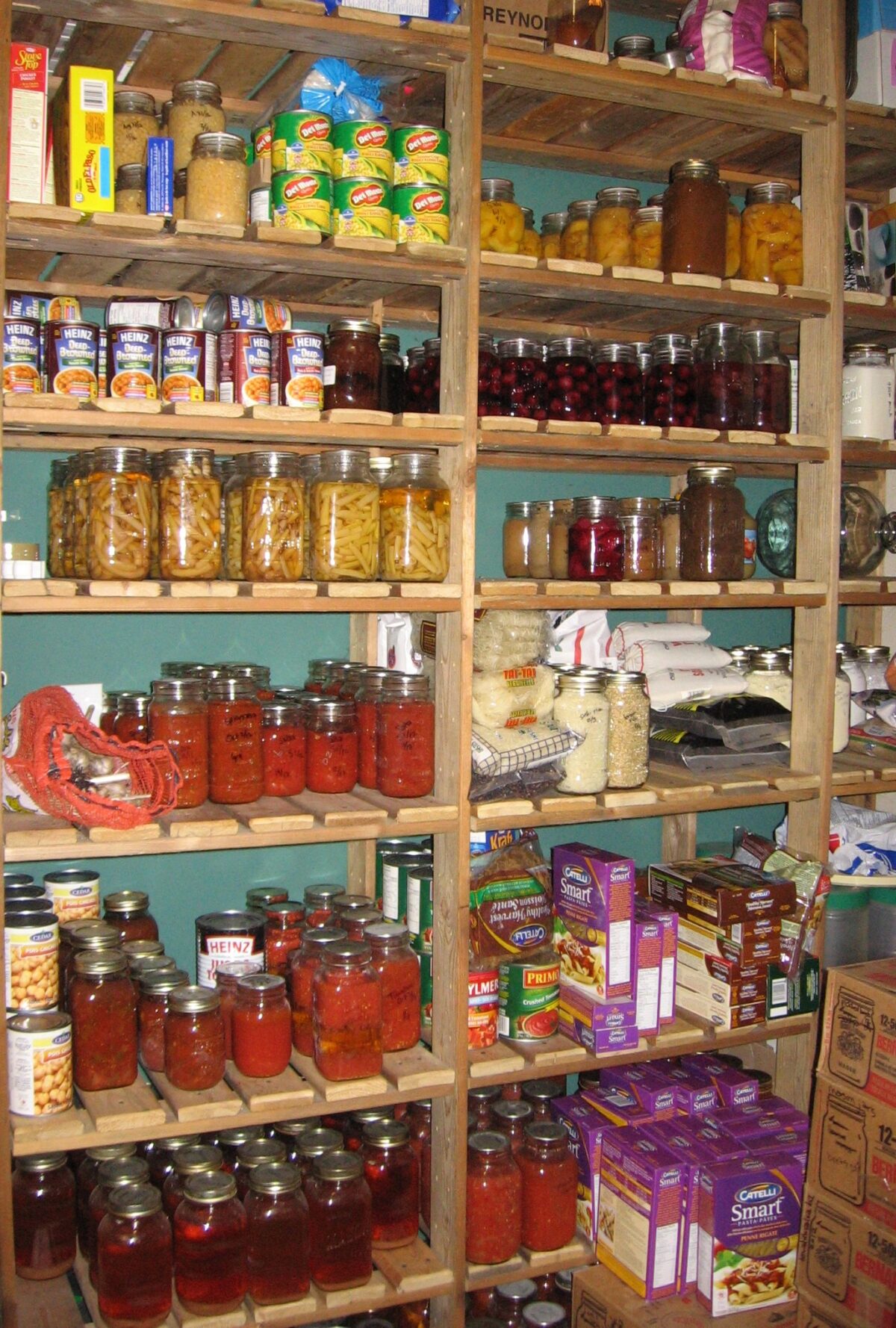
Raising a Family
Yves and Velvet built in chunks, as they had the money. They would buy $10,000 of materials, build, then pay off the line of credit and start again. Velvet said, “If you’re building your own house, there can be a lot of stress. So we knew we had to take our time and not put the pressure on,” she said.
“We learned to enjoy our children, to grow up with them. You’d like to finish the roof today, but you don’t have to.”
The house is earth-bermed, which means that earth is banked around and on top. As a result, the house appears to be built into a hill, with grass growing up and over it. They used to toboggan off the roof of the house in the winter, and in the summer they lay on the roof and read books.
One of Velvet’s best memories of the summer when they began to build the house is lying on the roof and reading “Harry Potter” to the boys.
“We read that whole series when we were building the house, and what a blessing that was. It was amazing,” she recalled.
From that first summer of building onward, the children were brought up to enjoy lazy days reading in a hammock, making mazes and forts with building materials, watching the patterns of weather and wildlife, and focusing on experiences rather than objects. As they grew up, their birthday parties were events that all their friends looked forward to. Instead of gifts, friends were asked to make something creative, which led to the sharing of many great desserts.
“Our children were famous for their gigantic cookie gifts for their friends,” said Velvet. “Not only the child whose birthday it was, but all of their friends who were going to the party, would ask if our children were bringing a giant cookie. They were always a hit!”
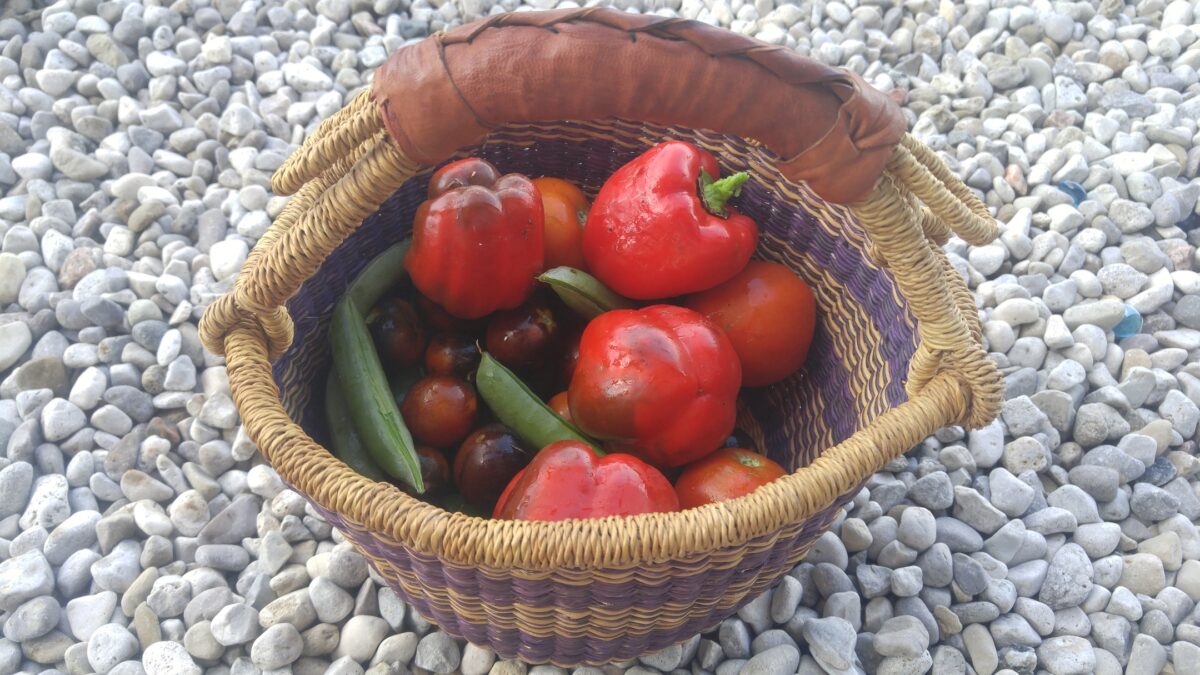
Lessons Lived and Learned
The Rollins live about 20 minutes from the nearest town, and once they felt a bit off-map as well as off-grid. One night in 2011, Yves and Velvet were out for the evening, and as they returned up their long driveway, they saw an orange glow ahead. The generator shed was on fire, along with two years’ worth of stored wood for the wood stove.
“It took a long time for the firefighters to get there,” said Velvet, “because they couldn’t find us! They found the end of the driveway but couldn’t see anything from there. They didn’t want to risk taking a truck down and getting stuck.” Eventually, Velvet drove up the driveway to meet the firefighters and guide them back to the house.
“Now the generator is in a steel shed with a concrete slab, and the propane tank is further away from the house,” said Yves. “We learned a few things!”
Growing up off-grid was a challenge for both of their sons, who missed living closer to their friends and were often frustrated. Velvet also acknowledged that “we did not realize our children found it as hard as they did when they were children—the power and water use issues.” The fire in the generator shed was a direct consequence of the kids trying to have access to more power. However, now that they are grown and living in cities, both their sons say that they are more careful in their use of water and power than their peers.
It’s been a life of learning, experimenting, and figuring things out along the way. From observing animal prints in the snow while walking to the children’s bus stop on winter mornings, to living without a kitchen sink before plumbing could be installed in the kitchen, to building an earth-bermed bunny barn for raising rabbits, to realizing that their own dog was the culprit damaging the garden, the family has watched the weather, adapted their lives, learned to be creative and self-sufficient, and taken their journey one day at a time.
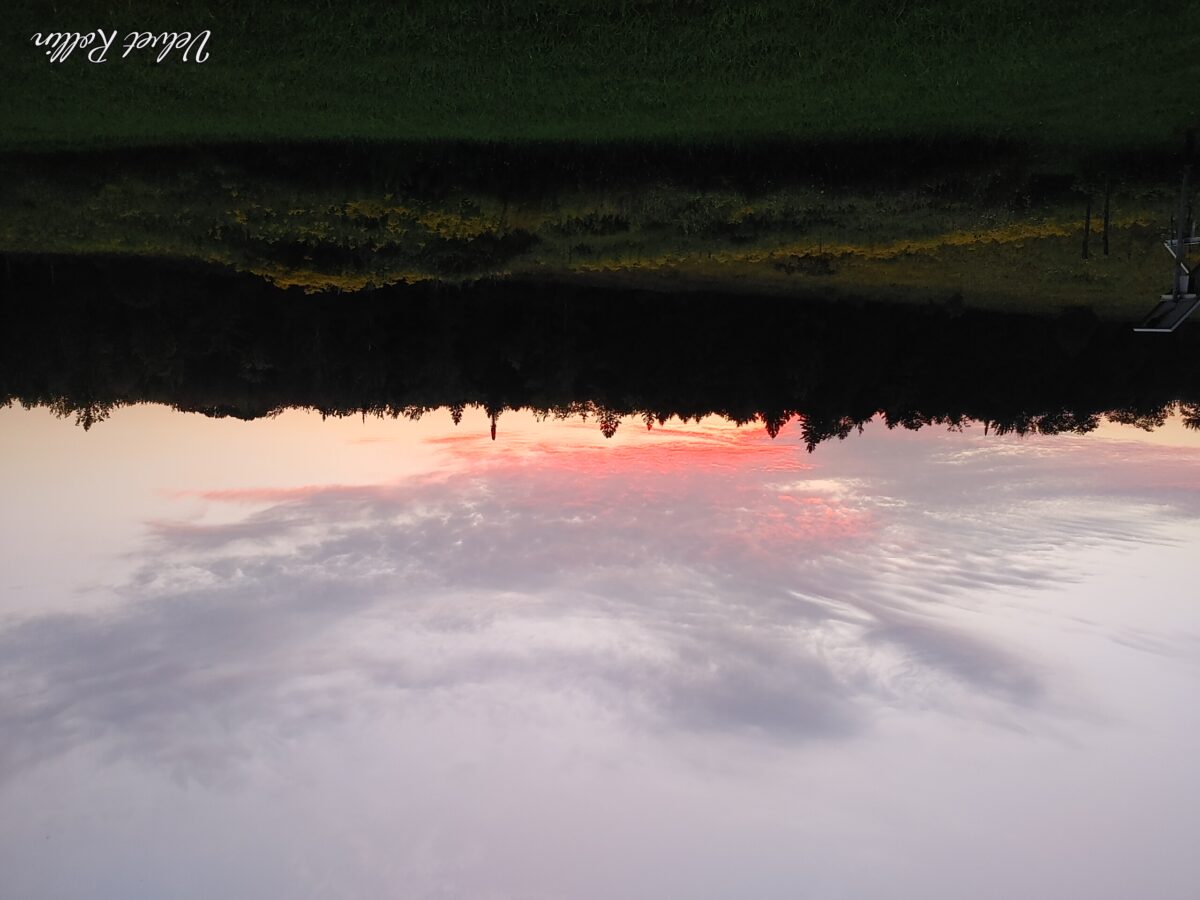
Tips From an Expert Gardener and Food Preserver
Gardening
One of Velvet’s top tips for growing vegetables is rotating crops each year, to give the soil a break. She also advises succession planting for fast-growing and fast-ripening crops, such as peas, carrots, and lettuce.
She recommends considering the amount of space available for planting and the amount of space required by a particular vegetable. For example, she does not grow potatoes because they take up an enormous amount of growing space. Also, she says, they are readily and cheaply available from local farmers.
Grow what you love and you know you will eat. She does not grow broccoli because “it’s ready all at once and I can’t eat it that fast.” On the other hand, the Rollins love garlic and grow “tons of it.”
Finally, try to guard and protect the garden against pests, which can include critters and beetles. Yves uses what he calls “whirligigs,” small windmills, to ward off chipmunks and rabbits, and Velvet covers one row of plants that are prone to beetle infestations. Try, also, to be sure that it’s not your own dog wreaking havoc when your back is turned!

Food Storage
“Store what you eat.” There is no point to having loads of tinned peaches on hand if no one in the family eats them. “Make a list of your family’s top meals and start storing ingredients for those,” Velvet advised.
“Eat what you store, otherwise you are wasting your money and food others would love to have access to. In the past some people bought food, stored it for a rainy day, but having had no rainy days, never ate it. In 30 years they opened it to discover that some of it had long gone bad.” Therefore, Velvet says, rotate your food.
“Slow and steady wins the race. As Covid-19 taught us, I hope, even when stores are struggling to bring in more food, more food will arrive. If you are starting to store food today, start slow and do what you can afford to do—instead of buying one can of tuna on sale, buy five cans.” Velvet advises against listening to fear-mongering messaging, as that can lead to feelings of overwhelm, which can make you shut down. Take things gradually, and don’t pressure yourself or your bank balance.
“Store some comfort foods and junk food–or ingredients to make your favorite junk foods.” Even in hard times, perhaps especially in hard times, people need an occasional indulgence.
“Travel this path with others and make it fun! If you make it fun, you will do it!” There are Facebook groups, for example, dedicated to the subjects of food storage, canning, dehydrating, and more. You can connect with a community of people sharing tips, ideas, success stories, and support. Velvet said, “Everyone I know personally who is storing food is doing so for more than themselves—they are doing it for family members, neighbors, and friends. Most of us intend to help take care of others in larger emergencies.”
]]>If you incorporate flour into your BOB, how do you use it out in the woods?
Here are two means of using your flour while out in the wild I thought you might be able to glean something from.
I’ll start by saying that neither of these recipes is my own. I totally stole them from Creek Stewart of “Fat Guys in the Woods” (one of my favorite shows when it aired). He highlights these recipes in his field manual that we’d discussed in the top non-military field manuals post.
How to make stick bread (you’ll need a stick).
This is my favorite recipe of Creek’s. Why? Because it’s as simple as it gets. I don’t really follow his recipes to the letter, so this is my simple spin on stick bread.
I pack in a Ziploc sandwich bag full of flour. I put the Ziploc bag inside of another Ziploc bag to eliminate spills. Opening up your dry bag after a full hike at dinner time only to discover that there’s flour all over your MREs everywhere is a disheartening experience. That extra Ziploc is your insurance plan.
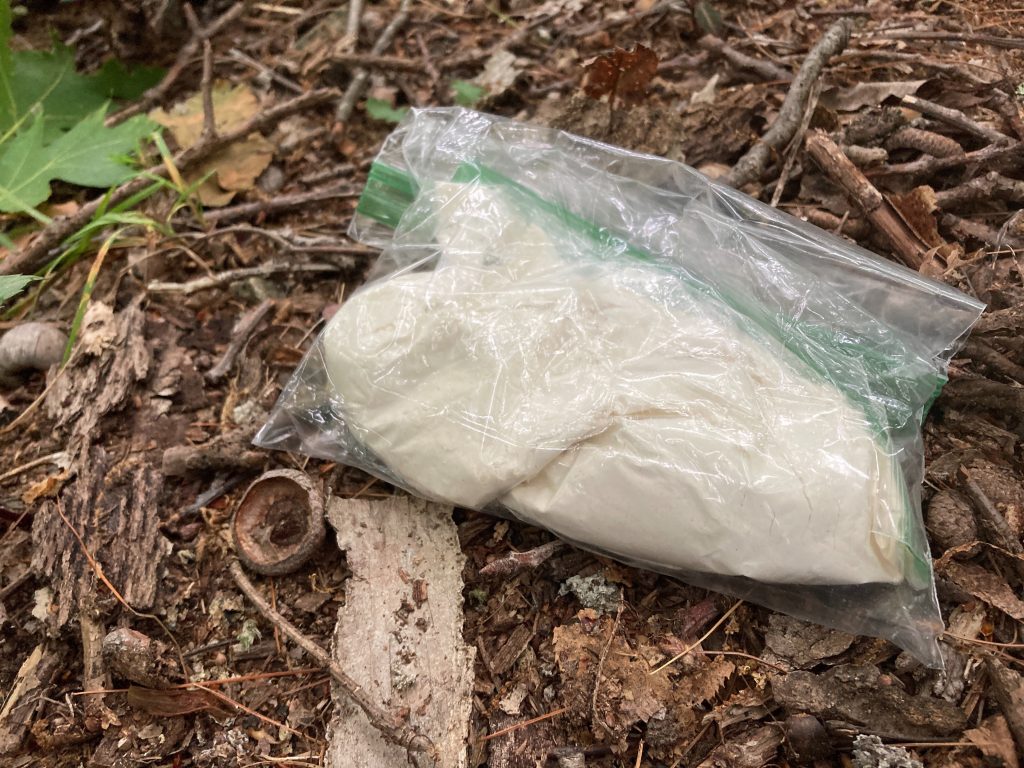
When setup time comes, I build a twiggy fire. That’s just a small campfire. There’s not a lot of signature with a twiggy fire, so if you’re concerned about that, this should help to ease your mind. You can always bake in the daytime if a light signature is a concern of yours as well.
I’m using a Kelly Kettle Hobo Stove in these pictures.
What I do is open up my Ziploc bag, pour in a bit of water until I end up with a dough mixture, and then Play-doh roll a snake/blob and put it on a stick that I’ve carved the bark off of. (My understanding here is that there are some sticks you shouldn’t use for this, but I’m not really sure what they are. Call me foolhardy, but I’ve always just picked a stick and hoped for the best. So far, so good. You probably want to figure this out.)
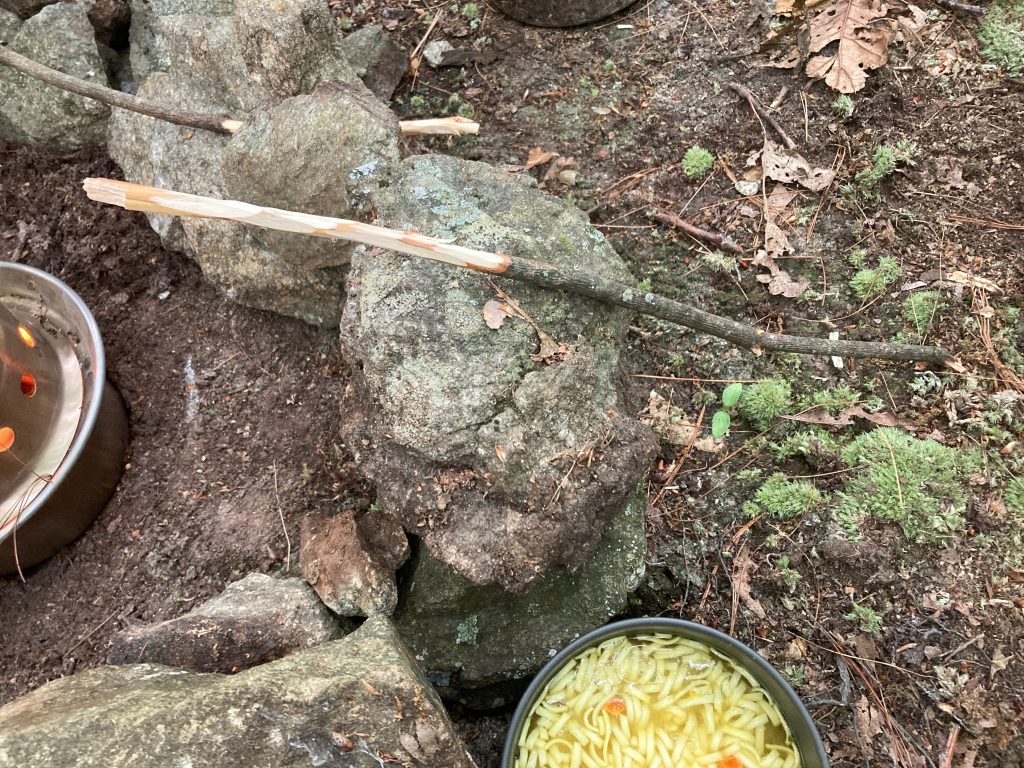
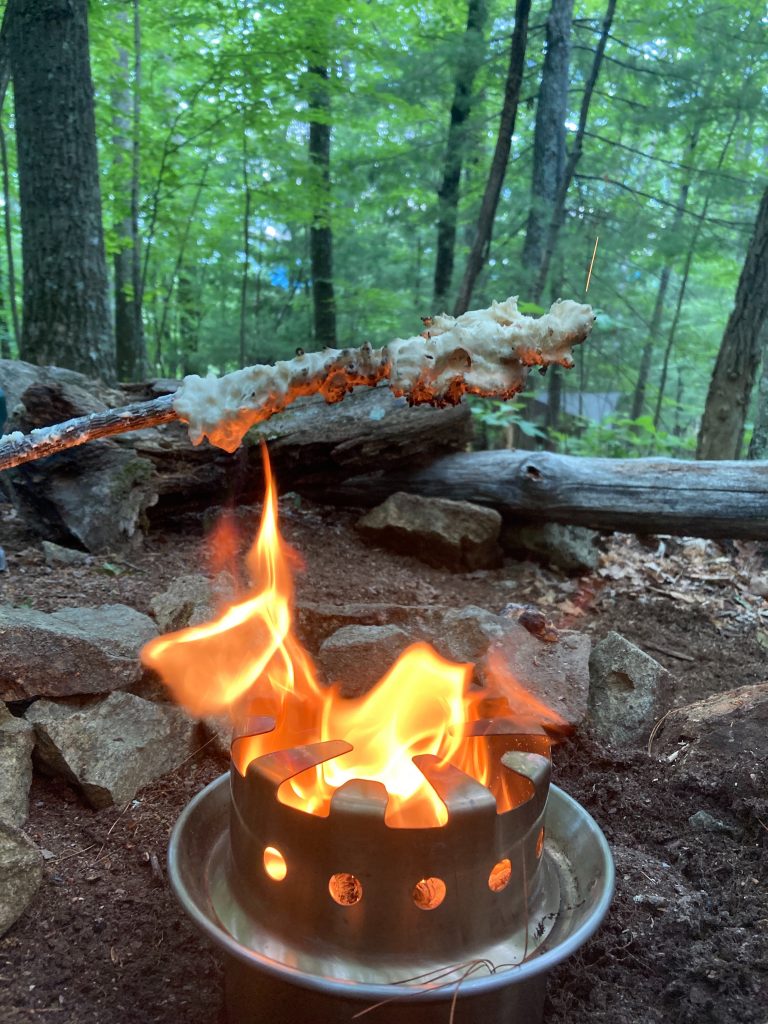
I then hold the dough-covered stick over the fire until it ends up turning into bread. Easy peezy. Creek says until golden brown, but mine always end up tinged with black.
Your hands will be covered with sticky flour mess after this process. I get it off by rubbing my hands together until it all peels off of its own accord. I don’t like going to sleep with bears thinking I smell like a biscuit.
(Don’t starve! Read our free QUICKSTART Guide to what to eat when the power goes out.)
How to make shovel cakes
According to Creek, farmhands used to rinse off their shovels in the creek at lunchtime and then use the spade head as a form of griddle to bake bread. Around here, my shovels are largely used to remove dead critters into the woods, so there’s no way I’m doing that. Even if I heated the spade head over a fire, there’s too much of a mental block there. (“I love opossum-flavored bread!”)
I’ll note that I made this bread off-grid here in the images, but not while sleeping out in the woods as I did with the stick bread images above.
Using my same Ziploc method, I used corn meal to fashion out a little cake on a little steel plate I was using as my frying pan. You do need butter for this recipe. It tastes very bland otherwise. I doubt you’re going to be carrying butter in your BOB, but if you’re at your house when you need to make some off-grid bread, this is something to consider.
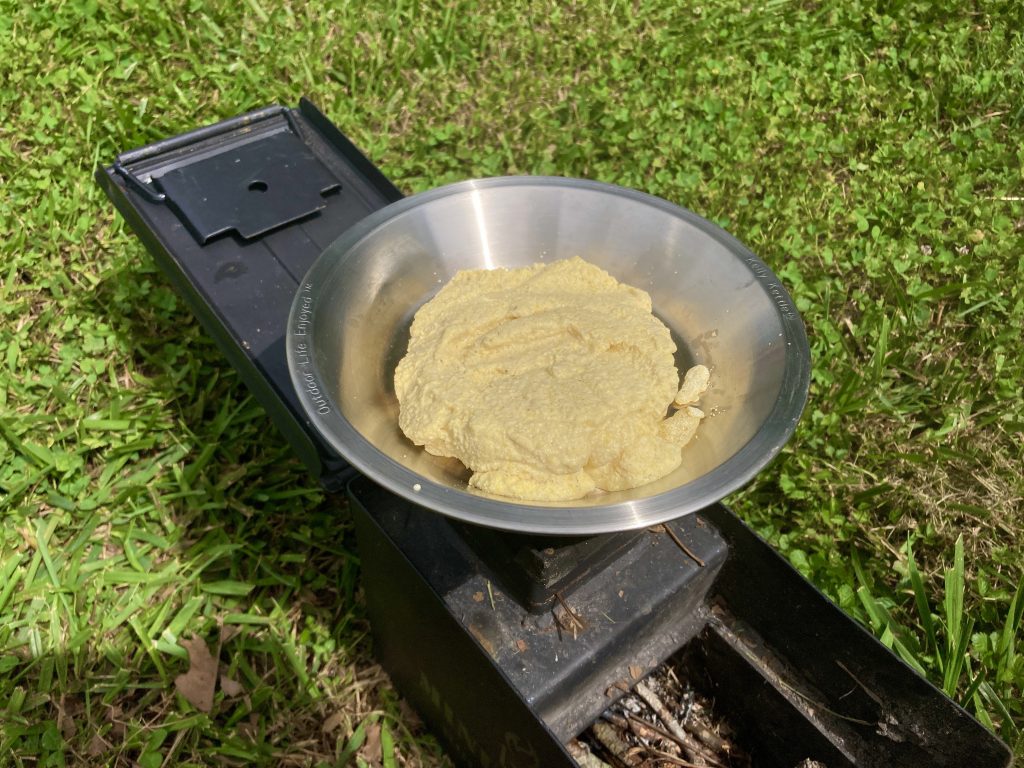
All you have to do is let the cake cook on one side until it’s tough enough to be flipped over without breaking into a bunch of pieces. Then, cook the other side for a few minutes, and you’ve made yourself a “shovel cake,” aka a big piece of cornbread.
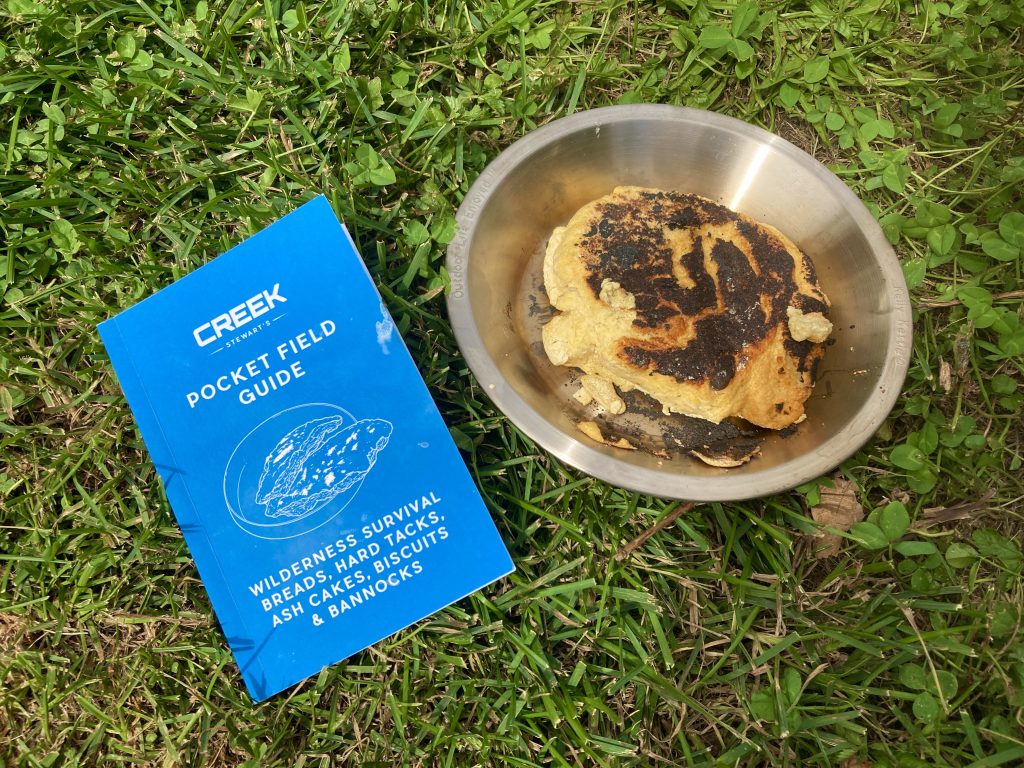
Both of these are super simple off-grid bread recipes.
Bread is fairly easy to make, even if you would never consider yourself a Martha Stewart. My version of off-grid stick bread is really nothing more than flour and water. I wouldn’t want to eat it as the main course, but it is very satisfying as a side dish while you’re out in the woods. If you’ve got more Guy Fieri flair than I do, you could easily add in whatever other ingredients and spices to make these dishes more palatable.
The stick bread could easily benefit from some type of herb, something easy enough to add to your BOB. Shovel cakes simply need butter, and they’re delicious. If you can figure out a way to get eggs with you out into the woods in one piece, you have even more options at your fingertips as well.
What are your thoughts on off-grid bread, however? Are there other recipes or methods that you can recommend? Let us know what you’re thinking in the comments below. (Also, if you’ve read Creek’s apocalyptic fiction book, let me know if it’s worth my money.)
About Aden
Aden Tate is a regular contributor to TheOrganicPrepper.com and TheFrugalite.com. Aden runs a micro-farm where he raises dairy goats, a pig, honeybees, meat chickens, laying chickens, tomatoes, mushrooms, and greens. Aden has four published books, The Faithful Prepper, An Arm and a Leg, The Prepper’s Guide to Post-Disaster Communications, and Zombie Choices. You can find his podcast The Last American on Preppers’ Broadcasting Network.
Article cross-posted from The Organic Prepper.
]]>